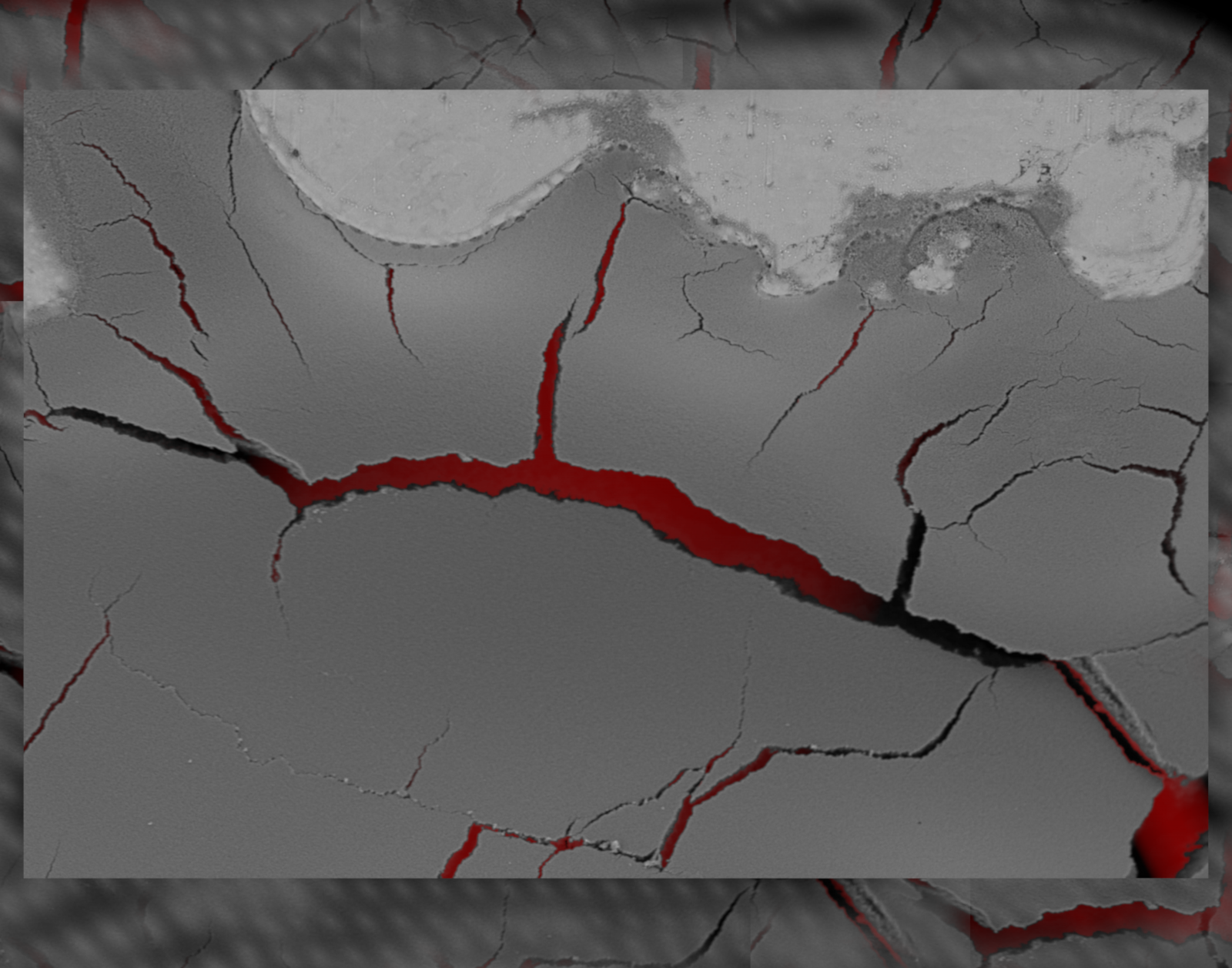Entry #1
"An Alloy-Flower Bloomed onto Cold Iron in the Fluoride Salts Universe "
Artist's Statement: Despite that tremendous driving force with high-temperature as like the big bang, the alloys that couldn't have been mixed into strong iron, finally they were settling on a barren surface as like blunt flowers. Even the flower that bloomed alone in a chaotic universe looks cold and weak, but once again feels the strength of iron. (Help: Even the electric-driven force in molten salts at 800°C was not enough to alloy Fe, and only the reduced Ca-based alloy was accidentally located on the substrate. We know that even that is going to disappear soon, because Ca is a very reactive metal) characters or less.
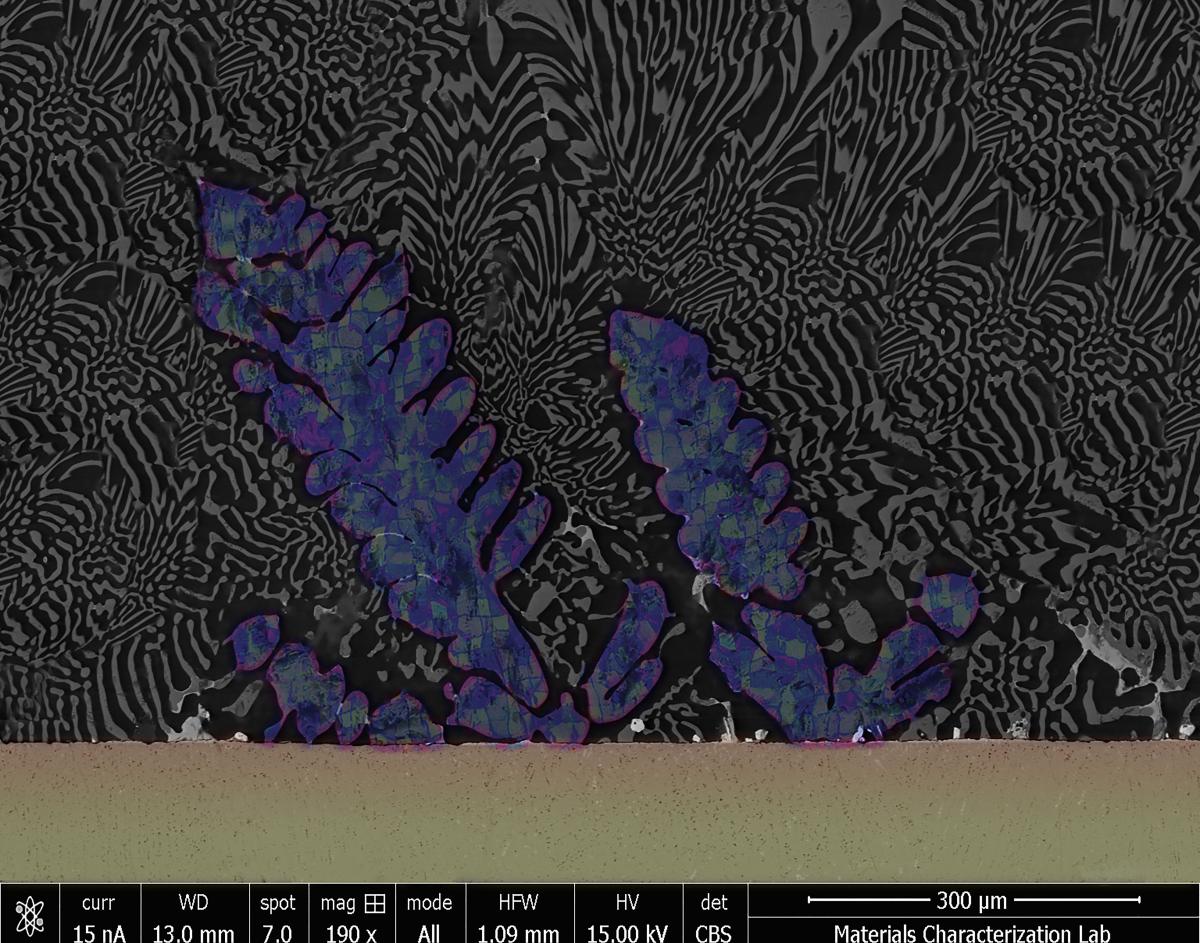
Entry #2
"Moon of Auspicious Clouds": Etched Silicon/Silicon Oxide-PMMA Interface by Sodium Hydroxide in a 2D Material Wet-Transfer Process"
Artist's Statement: I got this image by accident since we seldom observe the etched wafer surfaces after a transfer process, just because it is no longer needed or used. The image I took on such a surface simple shocked me as I never saw this naturally formed scene with mixed colors.
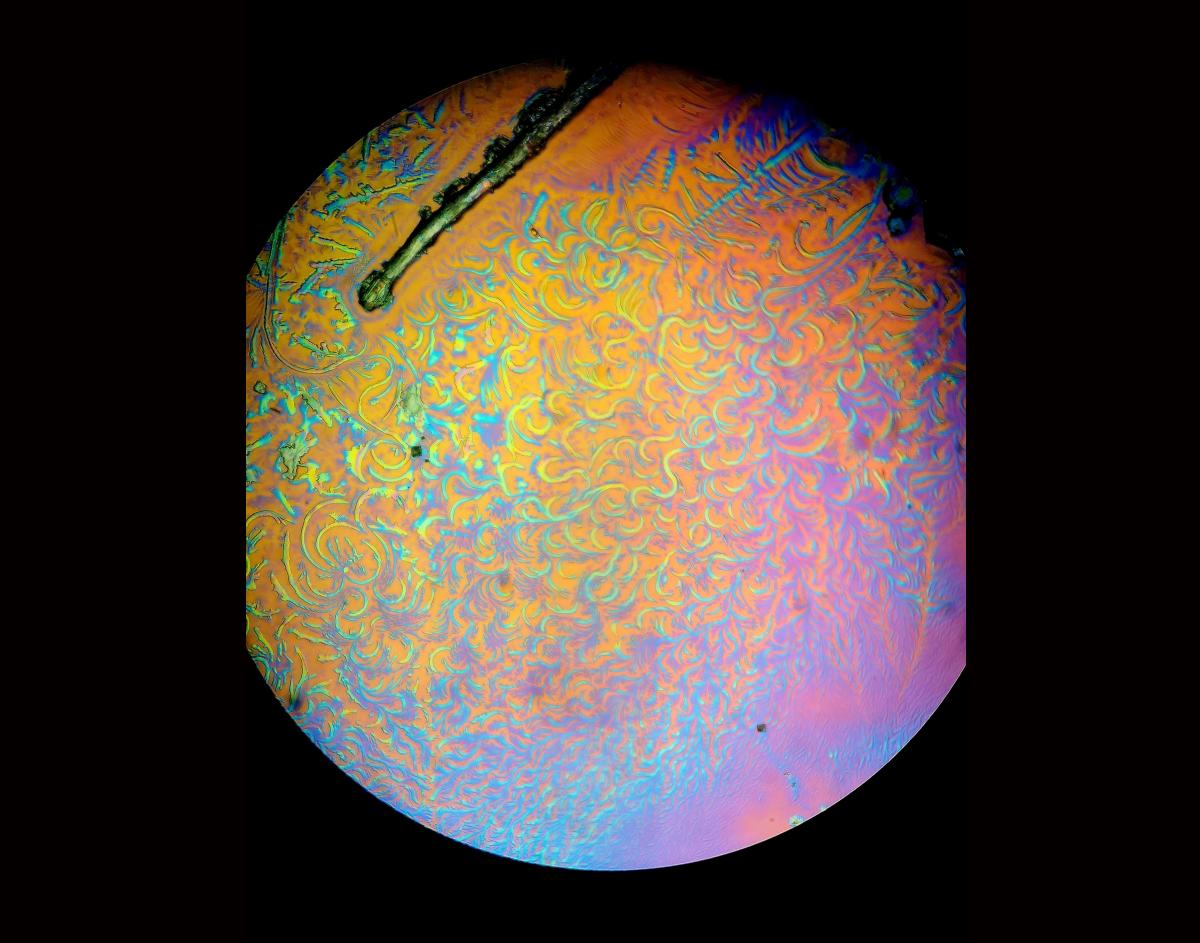
Entry #3
"A Micro-forest in a Nanofilm"
Artist's Statement: Dark field image of a transferred monolayer MoS2 film on a delaminated PMMA surface. The “roots” are micro-wrinkles in the film, while the forest floor is generated by the undulations on the PMMA surface.
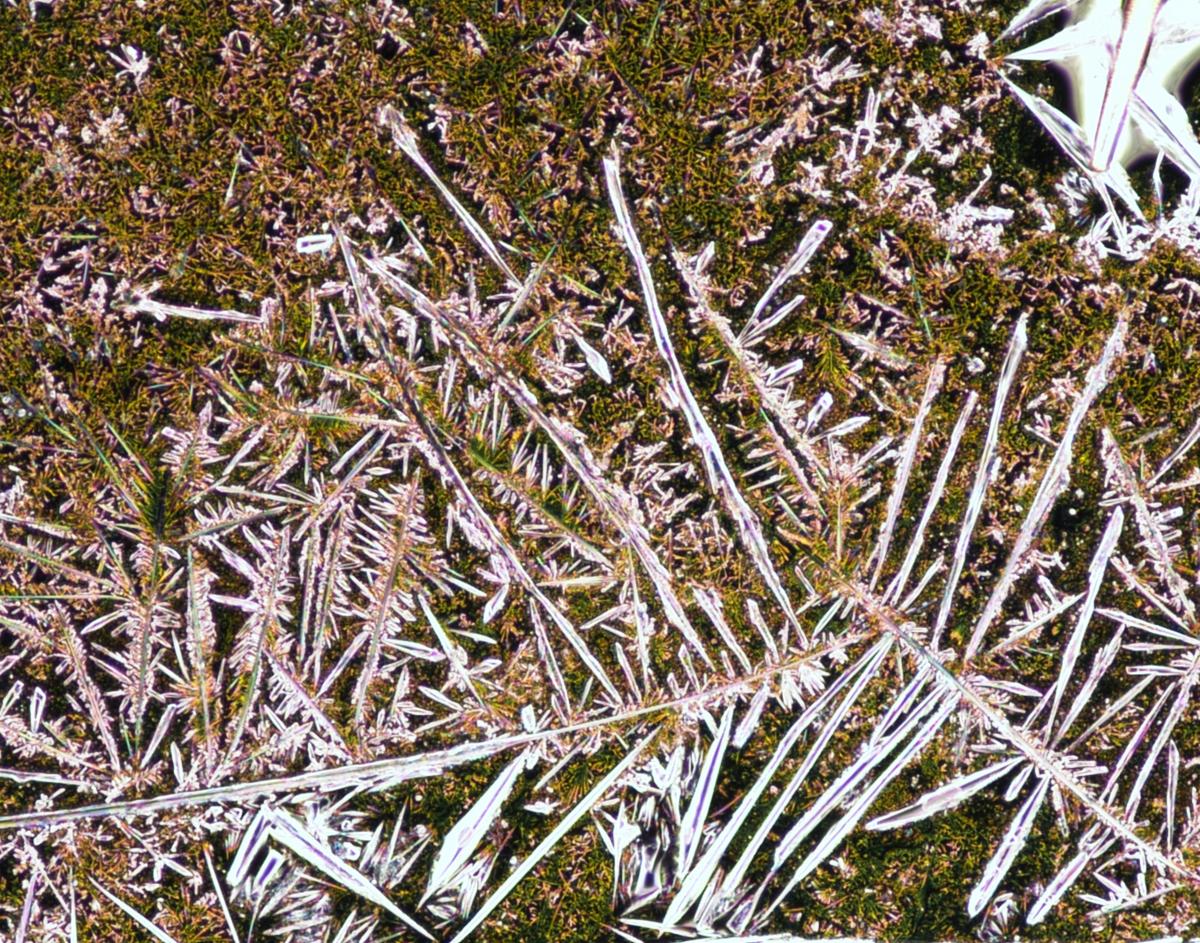
Entry #4
"Atomic Arch Bridge: Wisdom in the Quantum Realm"
Artist's Perspective: I came from Hangzhou, a beautiful city in China with over two thousand years of history. One of the best-known buildings in my hometown is called "Duan Qiao" or "the Broken Bridge" in English. The Broken Bridge is an arch bridge. The arc bridge has abutments at each end and is shaped like an arc, which elegantly transfers the its load into a horizontal force restrained by the abutment at each end. The design of the arc bridge highlights the wisdom of our ancestors. When I examined the high-entropy oxide thin film in the aberration-corrected TEM, I accidentally found a similar scene at the atomic scale, and it reminds me of the Broken Bridge in my hometown. I found a significant lattice mismatch causes the film spontaneously distort into this arc bridge form to accommodate the strain. Is this the wisdom of the quantum world? I don’t really have an answer. Maybe, the atoms share the wisdom of our forefathers in the quantum realm.
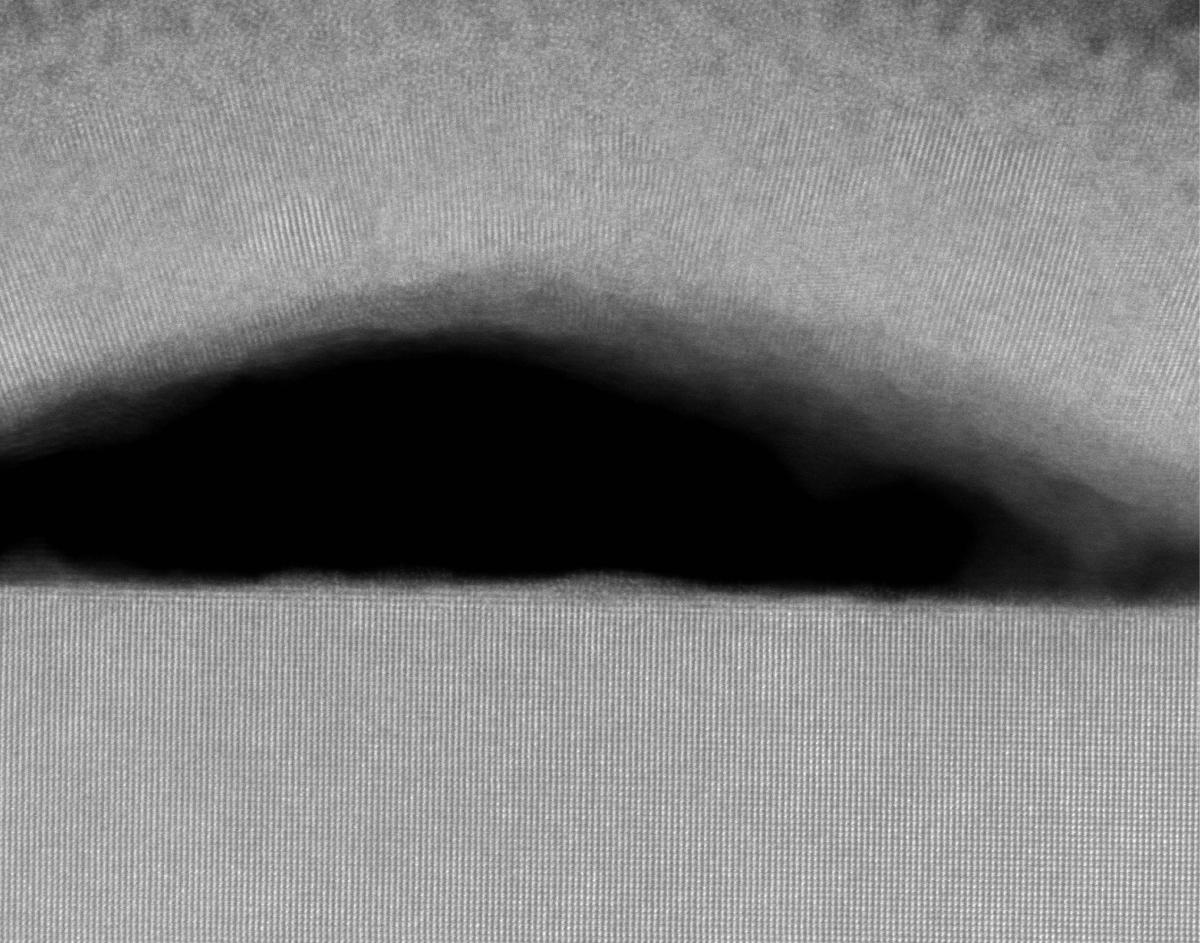
Entry #5
"Forest fire in two-dimensional (2D) materials"
Artist's Perspective: Atomic edge sites in two-dimensional (2D) materials are energetically different from the rest of the material because of the absence of bonding with some of the neighboring atoms. We call them dangling bonds. And, these act as nucleation centers when a second 2D material is grown subsequently to form heterostructures. Here, we see a zigzag line in the middle of the image which signifies the interface between two 2D materials: MoS2 on the left and ReS2 on the right. This is a result of growth of ReS2 from the edge of MoS2. False coloring of the image highlights the morphology difference between MoS2 and ReS2. While MoS2 is continuous, ReS2 is defective. These defects in ReS2 show up as green patches and hence make the image look like a forest fire that is advancing. The interface between the two materials is showing up as the edge of the forest.

Entry #6
"Islands of Microvoid Coalescence"
Artist's Perspective: 1,000 characters or leInvestigating a fracture surface is best likened to reading a book. In the minute details that can be captured, there is an entire story of what happened to the component. Revealing that complex narrative of crack initiation, propagation, and final failure is one of my favorite aspects of my work. In a specimen exhibiting such severe porosity as this, such a rapid failure would only qualify as a short story, but one in which I keep finding more beauty and nuance. The image was captured using secondary-electron imaging, and then adjusted for visual preference through brightness and contrast control. Finally, an unsharp mask was applied to accentuate the texture of the solidified melt pools. These image processing steps highlight the dynamic narrative of rapid, localized failure.
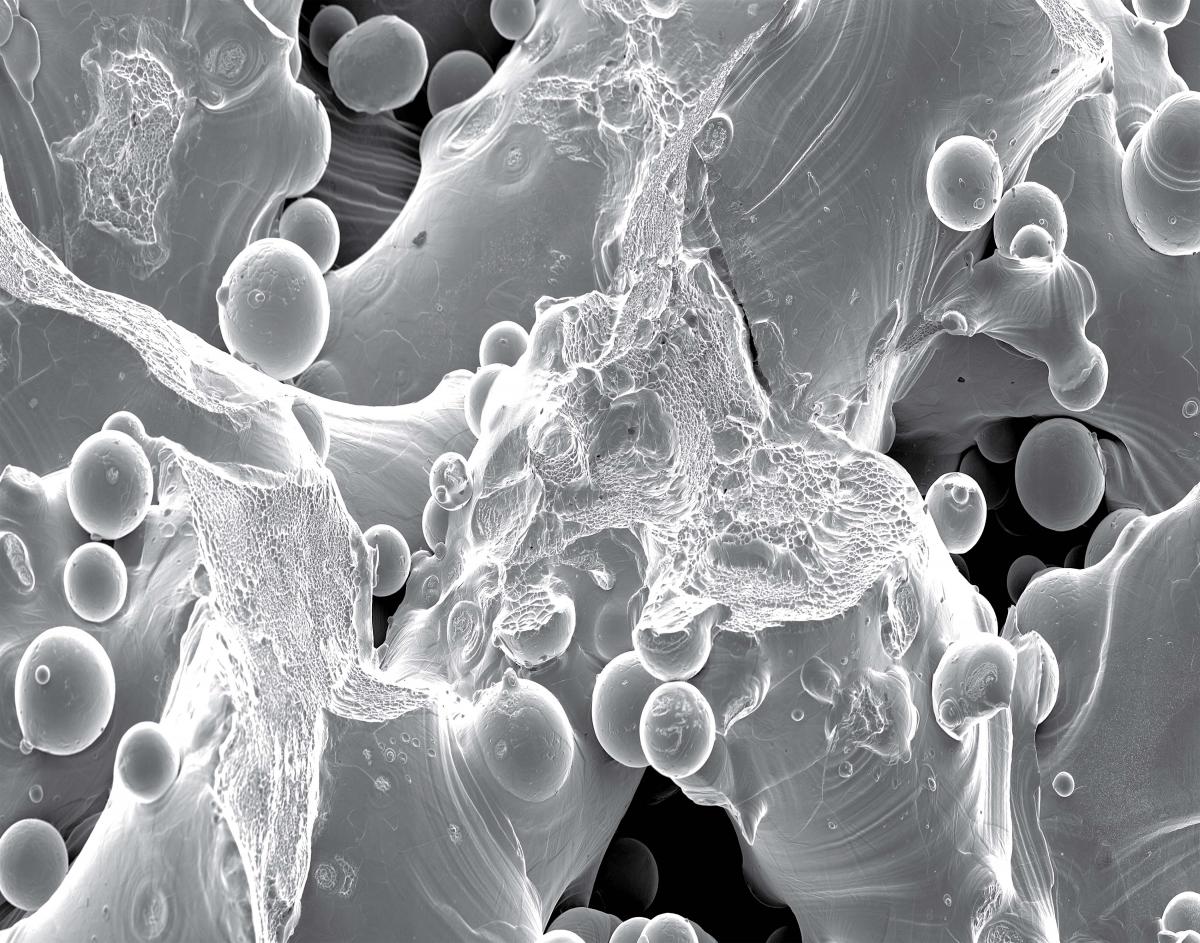
Entry #7
"Making the Inert Boron Nitride into the Reactive Surface"
Artist's Perspective: When the boron and nitrogen atoms are bonded alternating in these hexagon lattices, they constitute the most inert two-dimensional materials. However, the defects can lower the shield and make it a reactive surface. Light can be emitted from the vacancies, and metals can be deposited near the vacancies. Eventually, the vacancies enriched the life of the inert boron nitride.
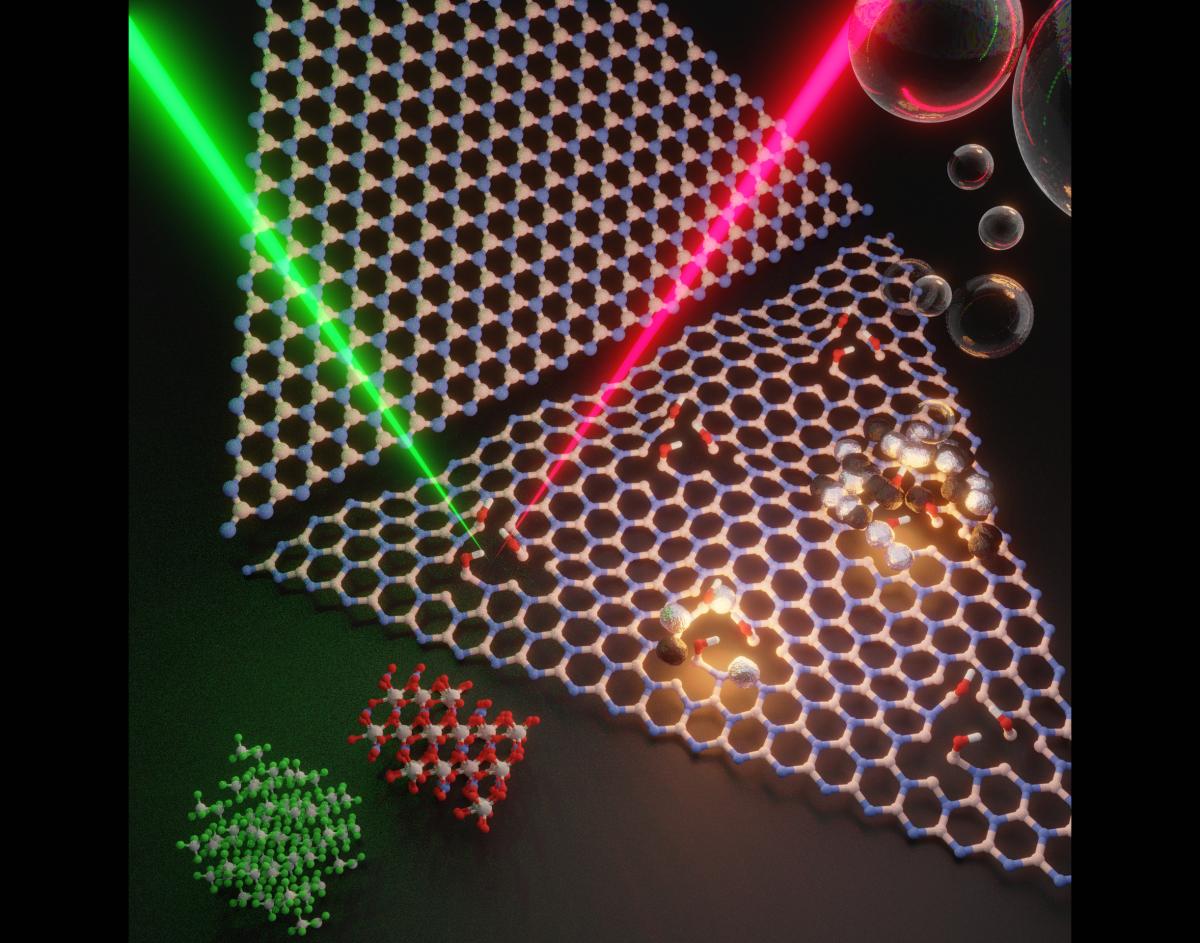
Entry #8
"Nanotulip"
Artist's Perspective: When we characterized the two-dimensionality of this newly discovered and grown layered material, we found this sample looks tulip! Wish everyone would reap the surprises of experiments and discover the beauty of life while doing scientific research.
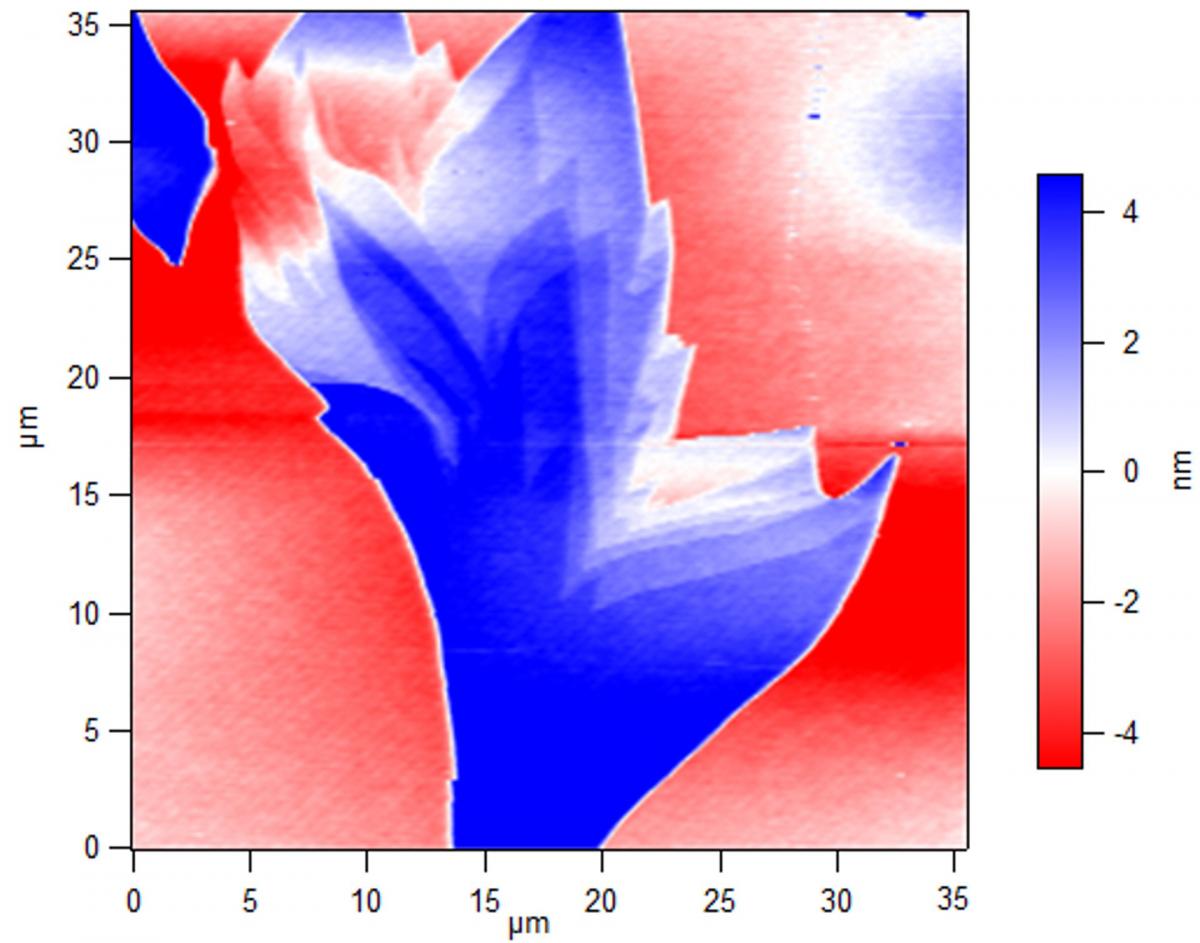
Entry #9
"'Cuneiform Script' at Micro-World"
Artist's Perspective: Cuneiform is one of ancient languages consists of hieroglyphic script to describe the early understanding of human being on nature. It is a primitive description of the world seen by our ancestor. Here we observed analogous 'script' with which we can understand the nature of the material (e.g., grain feature, lattice orientation, preferable growth, etc.) It is a language spoken by the material to show us the information of the micro-world.
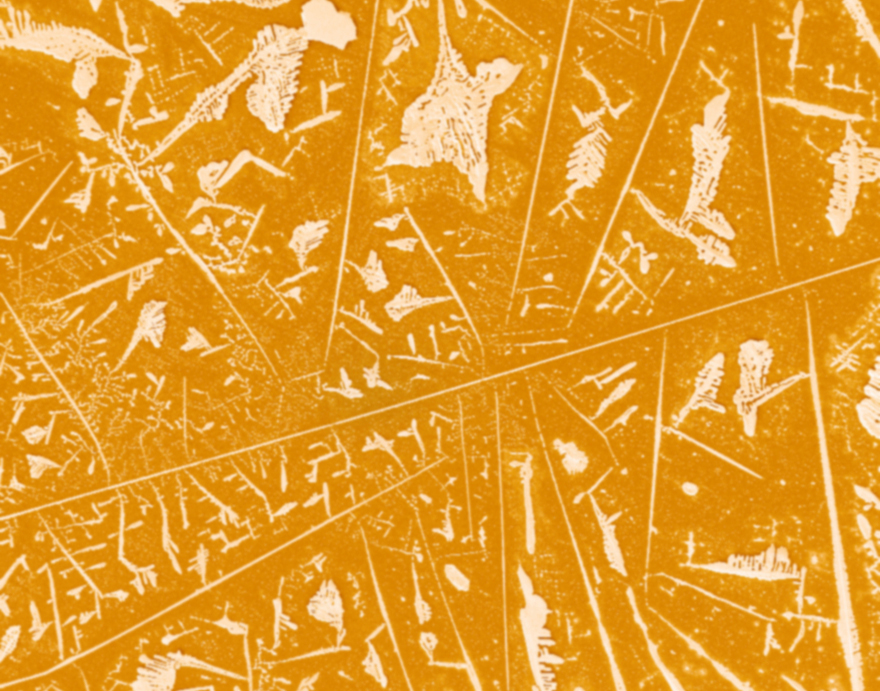
Entry #10
"Circular defect on a 2D-InN/graphene surface"
Artist's Perspective: Walking past MVC images in Steidle during my campus tour prior to my freshman year, I never thought I would be able to produce such a thing. However, after getting involved in undergraduate research my sophomore year, that narrative has changed. After only being able to submit a lousy AFM image in 2021, I have finally acquired the SEM skills ready to take down this competition!
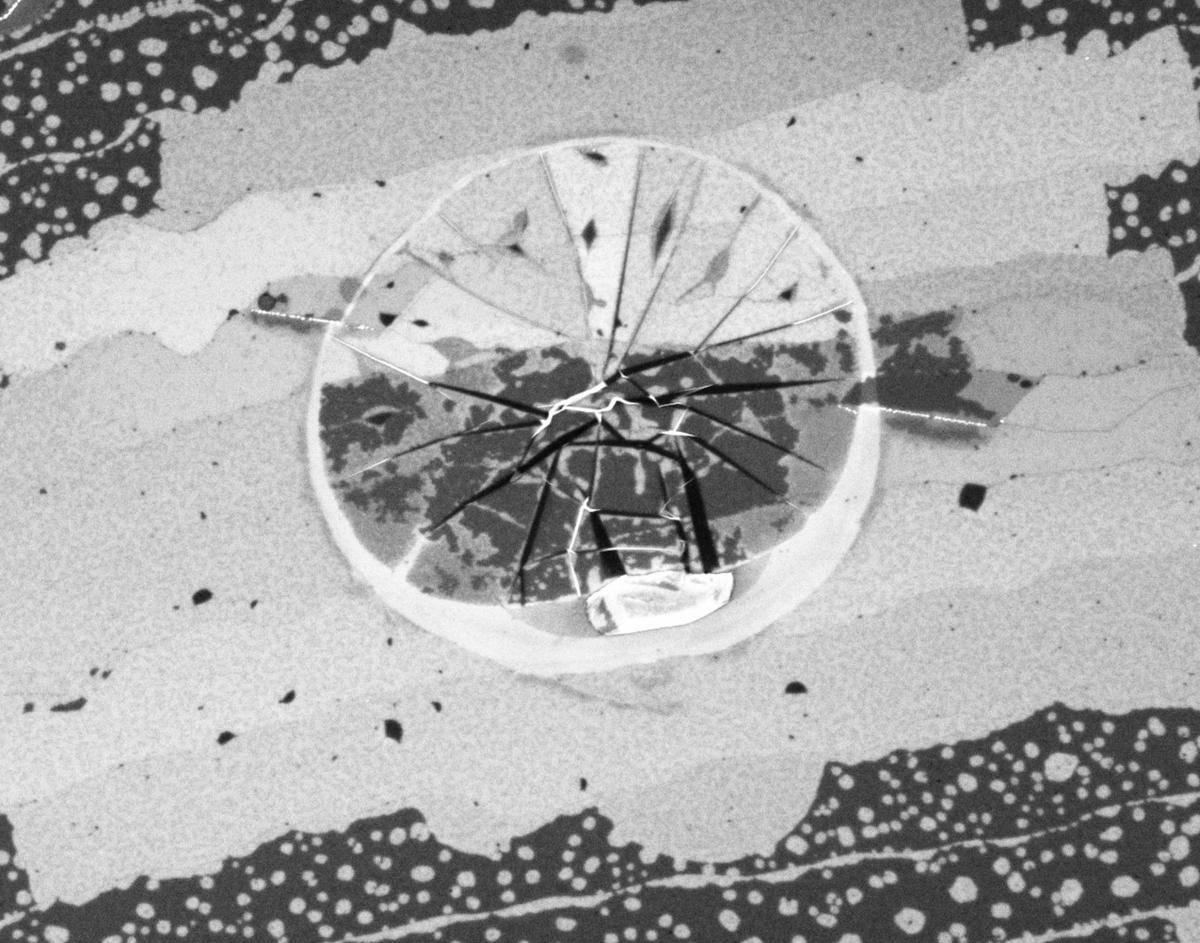
Entry #11
"Fracture"
Artist's Perspective: One of the many fascinating qualities of glass is how it interacts with light. My research allows me to see glass in many forms: molten, pristine, polished, fractured, and powdered. Each form serves a unique purpose and interacts with light differently. The beauty of glass changes during its lifetime, and glass can live forever. Glass starts molten like magma, then is cooled to solid shapes, and we call it pristine. Then I touch the glass and cut and grind it down to make it fit my needs, and it is no longer pristine. This glass is very strong and hard but with increasing pressure cracks begin to form. They emanate from walls and corners, seemingly random to me. But the glass knows exactly where it needs to break, I just don’t know glass as well as I think. I don’t know when or how a glass may come apart, but I know that whatever form it takes, it will still play with the light. When the usefulness of the glass ends, I return it to the furnace to become molten again and it produces its own light. Glass does not need to be pristine to be beautiful.
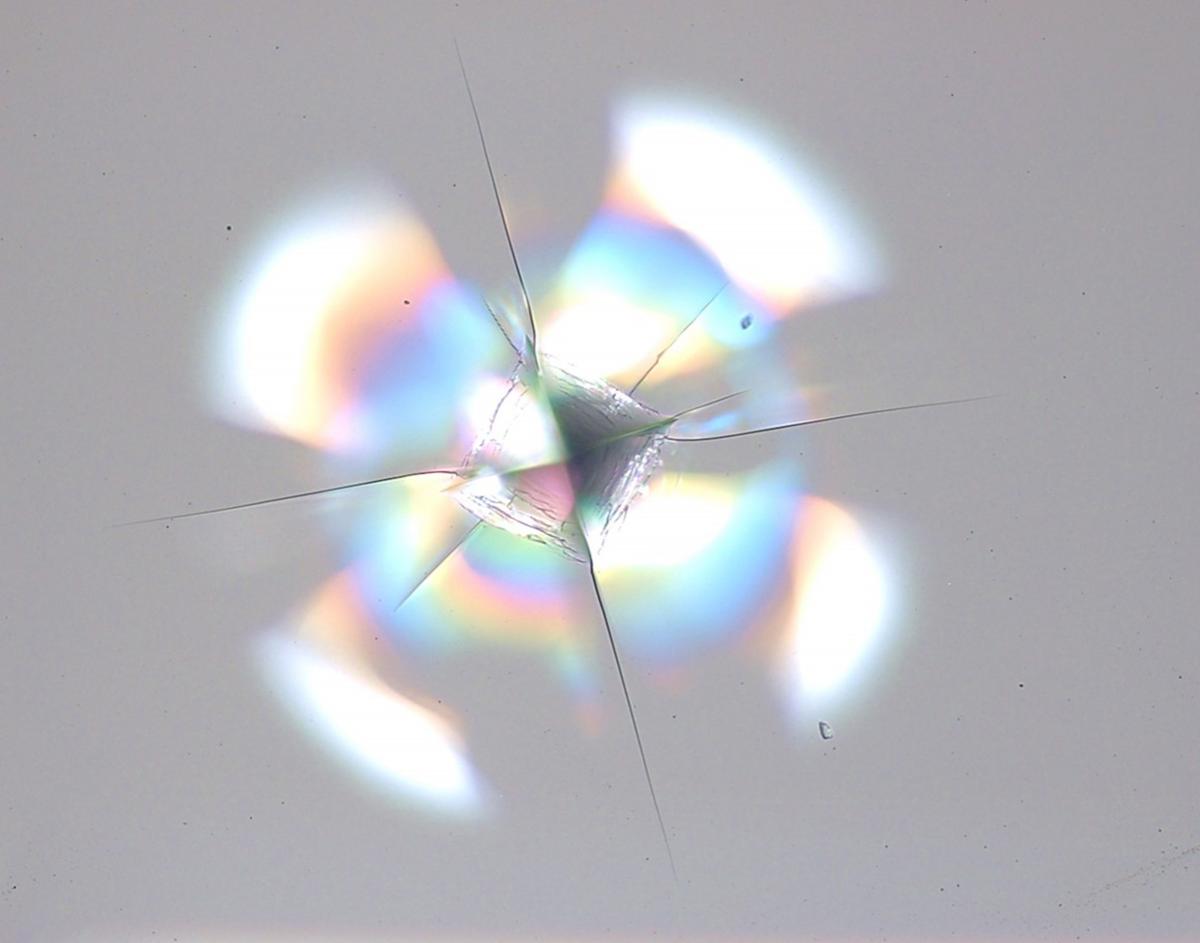
Entry #12
"‘The Adherens Junctions’: The key ‘artists’ behind epithelial cell-cell contacts"
Artist's Perspective: Sometimes, I wish, I was a painter. I remember performing microscopy experiments for the very first time and just getting amazed and awe-struck at how these cells look under the microscope. Fluorescence-based assays further enhance your visualization power as you can characterize the localization of target proteins inside the cellular body, and that too, with the help of colors. I always like to perform fluorescence staining assays as I get a chance to see such colorful patterns these cells make during microscopy.
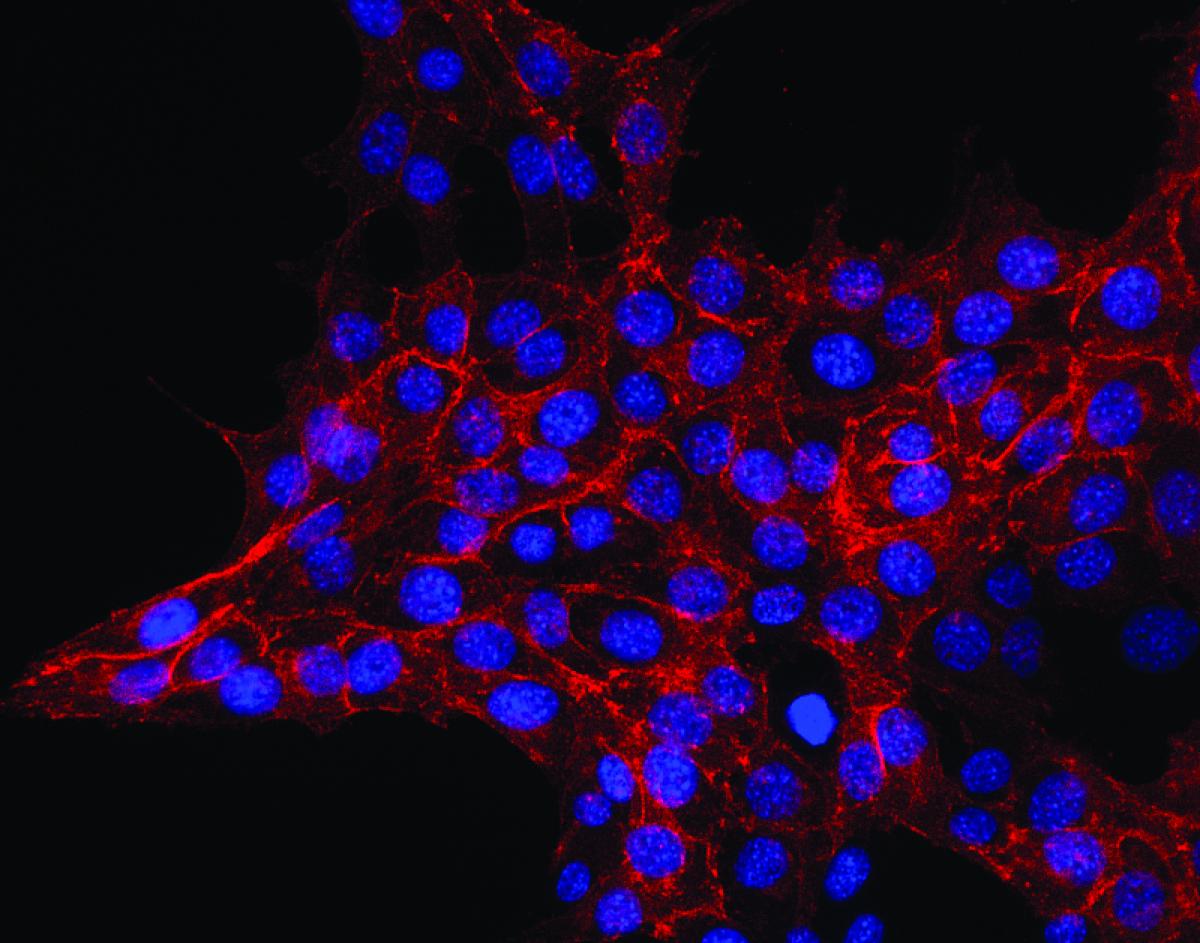
Entry #13
"Mo2C Crystals Floating on Water"
Artist's Perspective: The fact that carbides are stiff seems like based on a fairy tale. “Do we really look stiff at all?” says the wise fairy made of molybdenum carbide. “On the contrary!” says the lotus lying down on a lily pad and adds “you could even float on water if you let it go”. Amid competitive research environment, as human beings we all feel stiff and rough, even though ultimate relaxation is in our hands with “let it go” mentality.
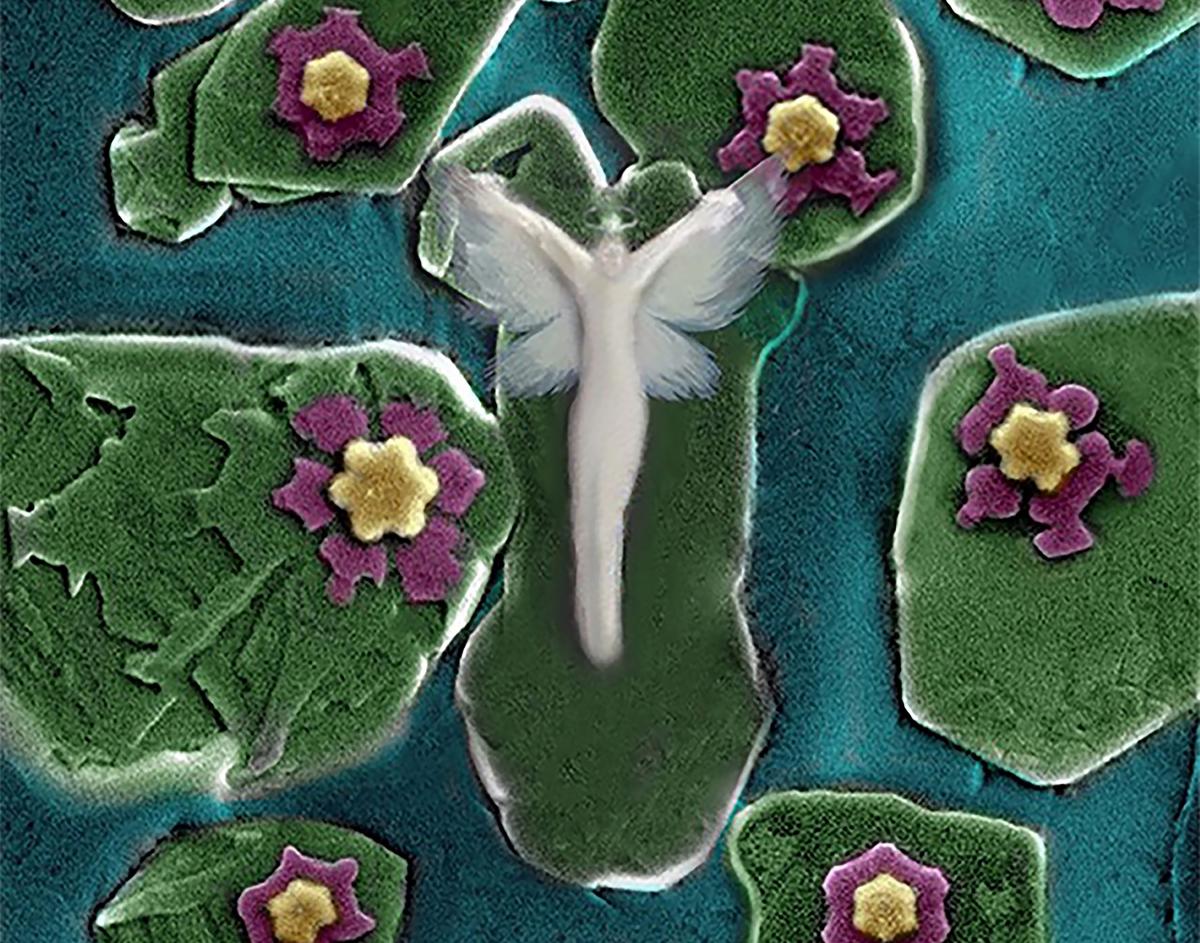
Entry #14
"Concrete for the Future – Lunar Regolith Simulant within an Ordinary Portland Cement Matrix"
Artist's Perspective: With plans to maintain a human presence on the lunar surface on the horizon, data is needed on how the in-situ lunar resources can be used for construction materials. The environment on the lunar surface poses multiple challenges that must be understood and overcome. The Microgravity Investigation of Cement Solidification (MICS) project is advancing the understanding of how gravity influences the solidification of concrete materials. Scanning electron microscopes can take beautiful images that have not only allowed for a deeper scientific understanding of the concrete materials in the MICS project but also a creative way to highlight the research results. The addition of color to the lunar simulant particles highlights the importance of utilizing in-situ lunar resources and a promising start to the next era of human space exploration.
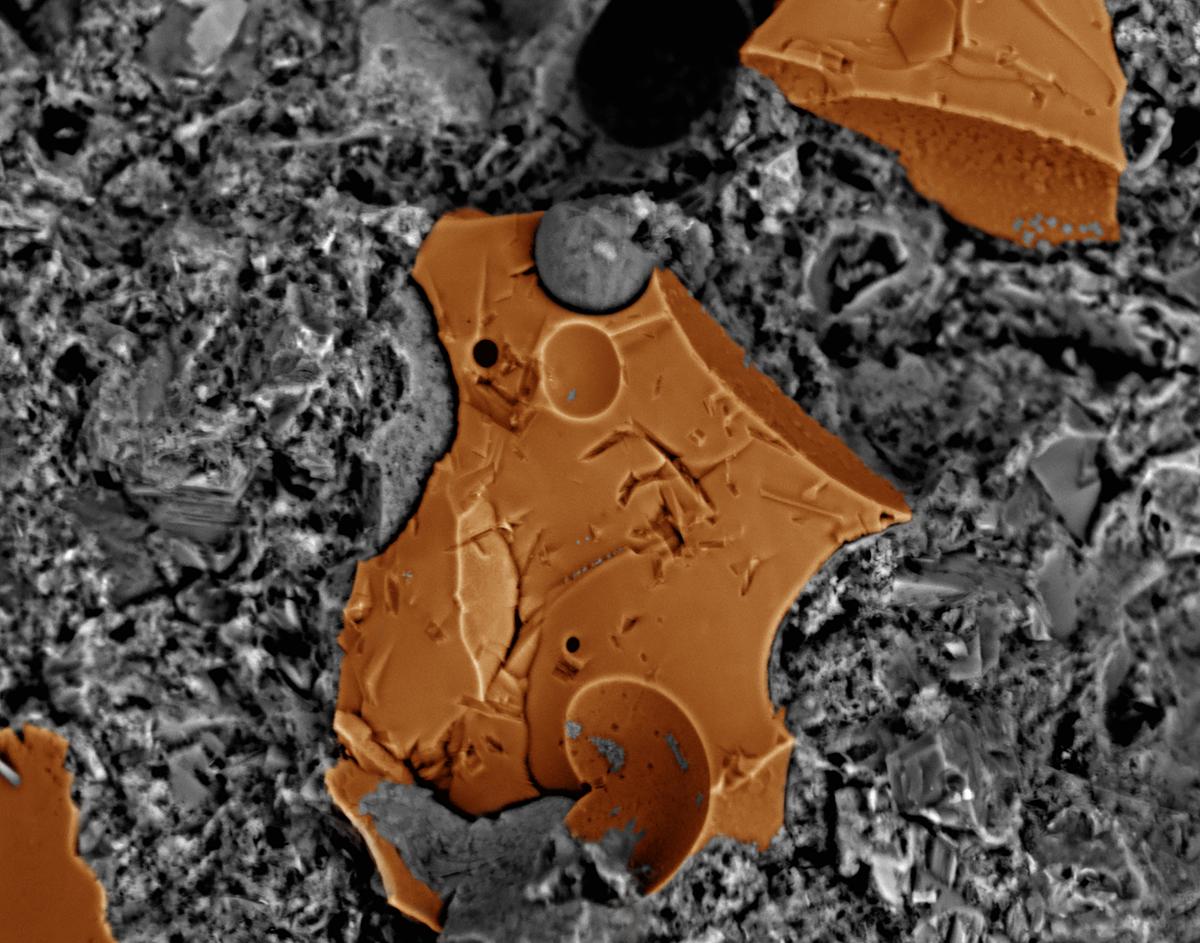
Entry #15
"Truffula Trees"
Artist's Perspective: A classic fable from my childhood was Dr. Seuss’s The Lorax. Like all Dr. Seuss stories, I fell in love with the colorful illustrations, whimsical language, and fictitious but captivating creatures that existed within the book pages. But The Lorax was different. As a child, I sensed a sadness permeating the story, but I didn’t fully comprehend why. Even though it’s a children’s book, The Lorax’s message on environmental preservation relates to people of all ages and backgrounds. Today, it’s message resonates strongly amidst the global challenges we face with a changing climate. It seems only fitting that the Lorax’s warning words are inspired by Truffula Trees hidden among the threads of fungal mycelium. A material celebrated for its biodegradable properties, mycelium-based materials are explored for their applications in sustainable design and environmental remediation. Fungi may be small, but they move through the world with surprising strength and adaptability as they grown on items from landfills, absorb heavy metals, and bind and support organic matter, only to return it to the natural soil. There is much work that needs to be done to create an environment where Truffula Trees can grow. Mycelium represents but one way to heal and preserve our world, so that maybe one day, the Lorax and his friends will come back.
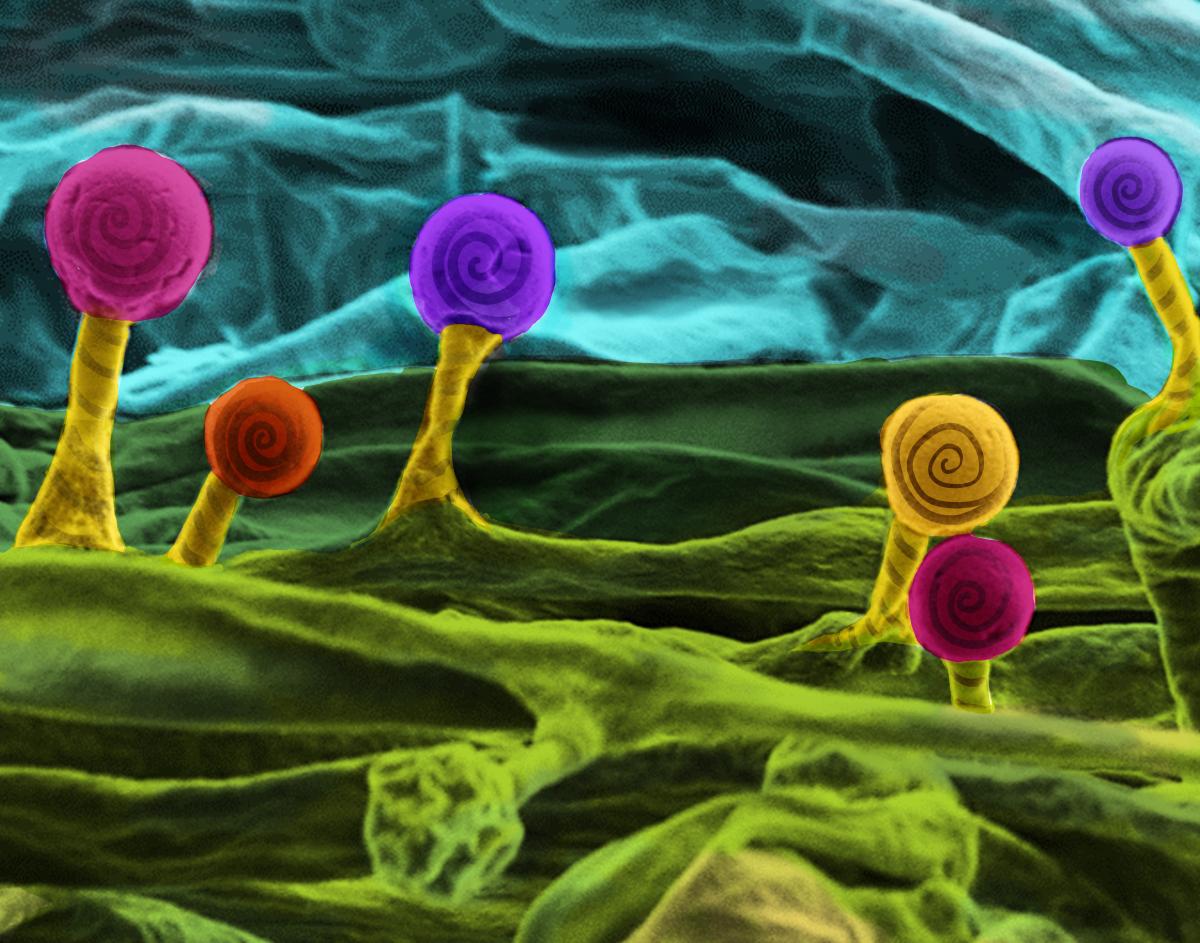
Entry #16
"Walking in a Wolfram Wonderland"
Artist's Perspective: When autumn turns to winter and the months grow colder, there is always something I look forward to: snow! Every time it snows, I catch a few snowflakes in my hand and stare at the crystals as long as I can before they melt; I also take a moment to gaze at the ice on my car windows while the engine warms up. Snowflakes remind me of the beautiful structures we can find in nature, from the honeycomb lattice of graphene to a night sky full of stars. As an experimentalist who spends much time synthesizing and characterizing materials, I marvel at how complex chemical reactions can produce beautiful yet similar structures in such different systems. Viewing these tungsten carbide crystals under the scanning electron microscope immediately reminded me of the snowflakes I have been catching in my hands since I was a child. Applying the cold colors helped me recreate a wintry scene that we are familiar with in State College!
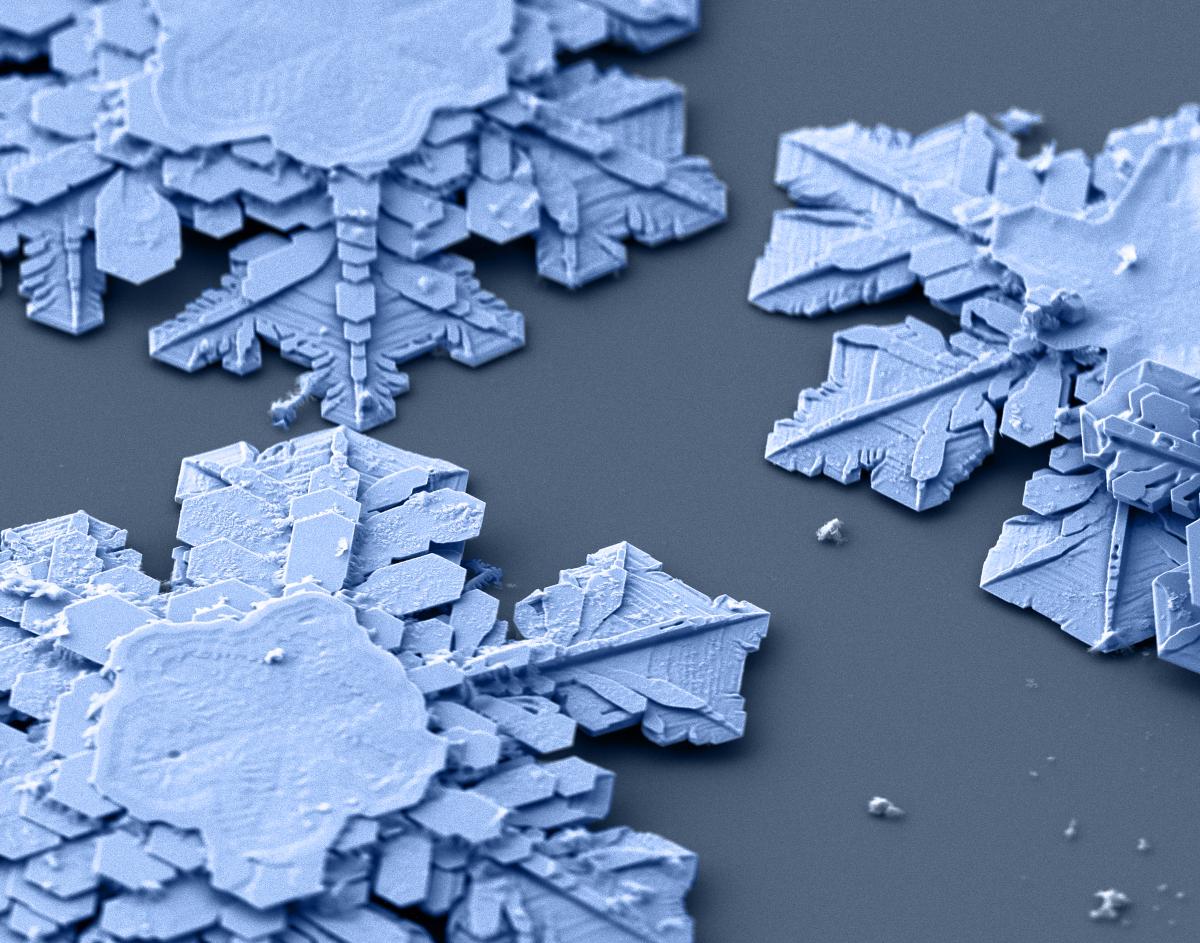
Entry #17
"Array of spin torque devices"
Artist's Perspective: As materials scientists we spend most of our time thinking about the basic characteristics of matter, usually considering materials that are a few atoms thick or electrons in an infinite periodic lattice. Modern lithography techniques allow us to break the barrier between these incredible useful microscopic abstractions and the macroscopic things that we can see, feel, touch and measure. Here we see how using gold wire that is thinner than a human hair we connect these two seemly disconnected worlds and in the case of this experiment, measure the spin of the electrons in a heavy metal.

Entry #18
"Steely Silver Linings"
Artisit's Perspective: I enjoy this image because the fractal-like nature of the grain structure is very appealing to the eye. Combining that with the texture in the martensite developed through etching as well as the bright outlines around the delta-ferrite presents a multi-dimensional piece that speak to both the rough and tough nature of steel as well as the intricate complexities the metallurgy of steel processing presents. My hope for the viewer is that you get lost as I do tracing the outlines, which I think of as the "Steely Silver Linings", of the grains presented brightly due to the polarized light and that one gets almost hypnotized by the seemingly simple yet chaotic and complex nature of the stainless steel microstructure.
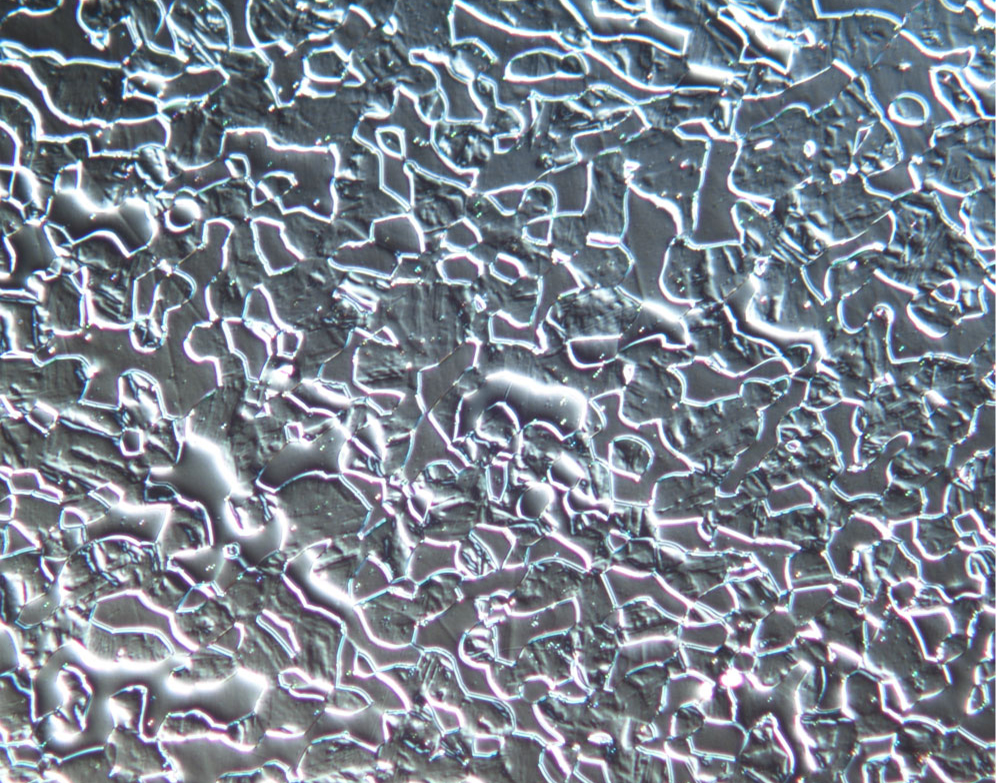
Entry #19
"Crystallization of Triblock Copolymers seen through Polarized Optical Microscopy"
Artist's Perspective: The striking colors of this image brought out by the polarized light on the semi-crystalline surface is what stood out the most to me. The unassuming glass substrate was transformed into beautifully colored artwork by the spherulites and crystalline domains of the polyethylene oxide blocks of the polymer. The contrast seen between the two regions of spherulites adds depth to the image. Overall, the way the polymer interacts with polarized light creates an array of beautiful jewel-like colors.
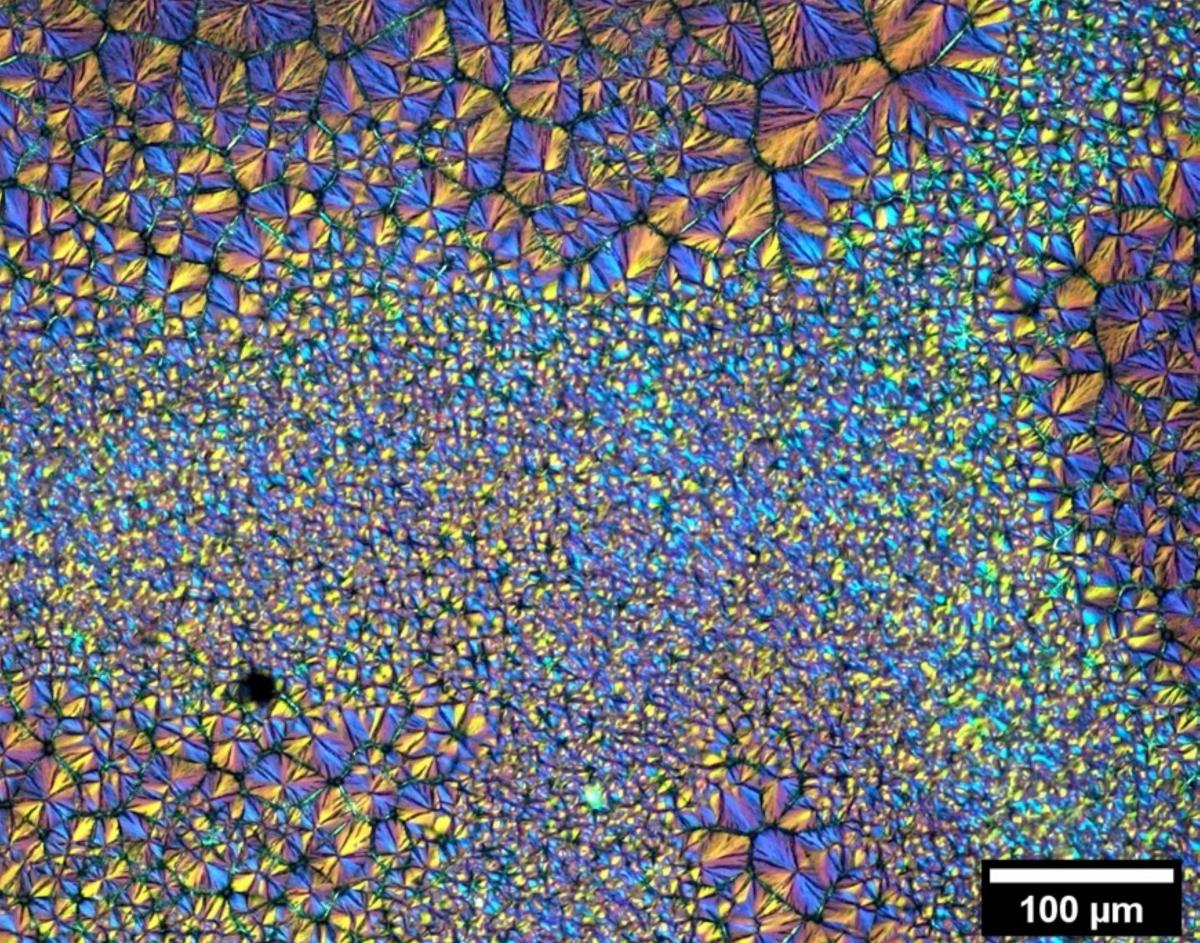
Entry #20
"Love Starts at the Cellular Level"
Artist's Perspective: As researchers we sacrifice many things in our lives for our work, be it: sleep, meals, social events, family time, hobbies and in extreme cases even our lives. But why do we do it? We do it for the love of research and the prospect of progress for humankind. After many failed attempts and bad results, I was able to obtain this sample. This image that I was able to capture may look like a heart, but what I see is different. When I look at it, I see that all my sacrifices and hard work are being recompensated. After pouring my heart and soul into the project and giving it love, the project finally loved me back. No matter how defeated you may feel remember that one day your projects will love you back.
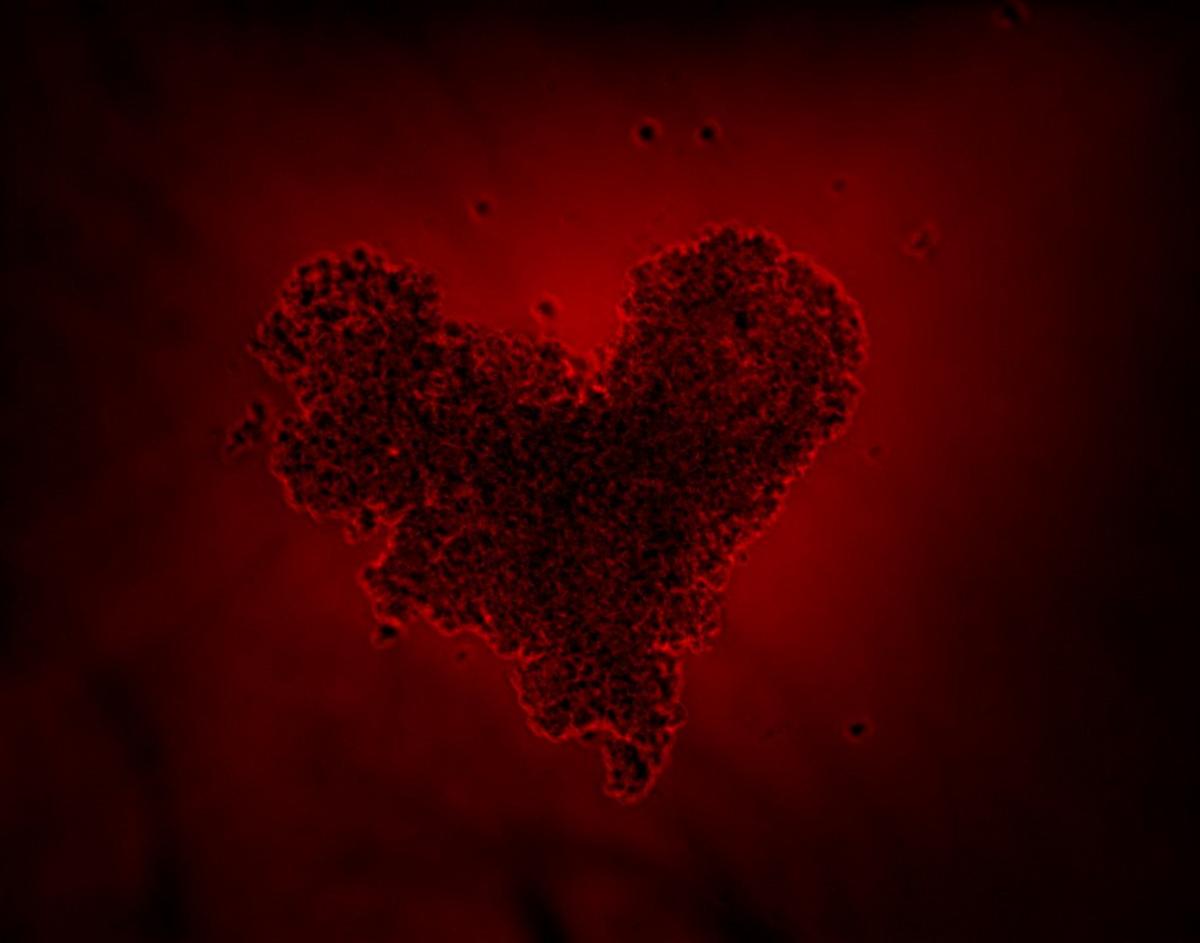
Entry #21
"The Happiest Connection of Cell Dimensions"
Artist's Perspective: Think about it, when was the last time you did something to touch others’ life? Probably, you always tried to make something that made only you feel amazing but didn’t make others feel the same as well. Whenever I witness new connections and dimensions under the microscope, I feel like how we lost all these bridges in this world. Here, two different dimensions of cells as 3D and 2D were physically represented by using a confocal microscope. They are trying to set a connection between dimensions and touch each others’ lives at the cellular level. I called it “the happiest connection of cell dimensions.” I can’t see, touch, hear or smell their happiness but can only feel it deeply.
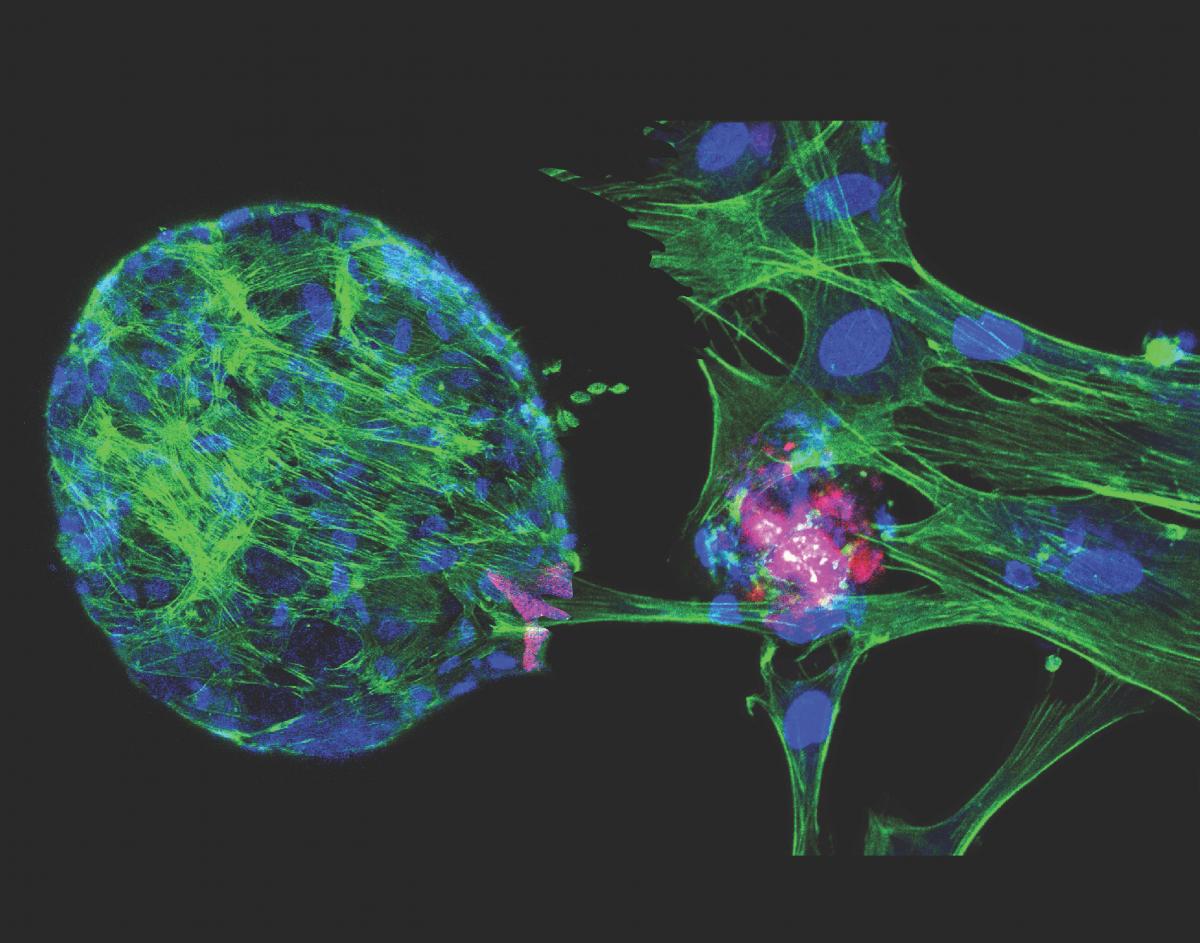
Entry #22
"Engineering Exotic Textures in Lead-Free Ferroelectric Heterostructures"
Artist's Perspective: Exotic topological textures require exotic colors and methods to standout. Here we transport the viewer into a kaleidoscope of colors and features to help emphasize the novel, exotic, and unusual properties of topological textures within ferroelectric domain states, as the light nittany blue rotates into the yellow goldenrod and back again throughout the vortex tubes that form in the heterostructure.
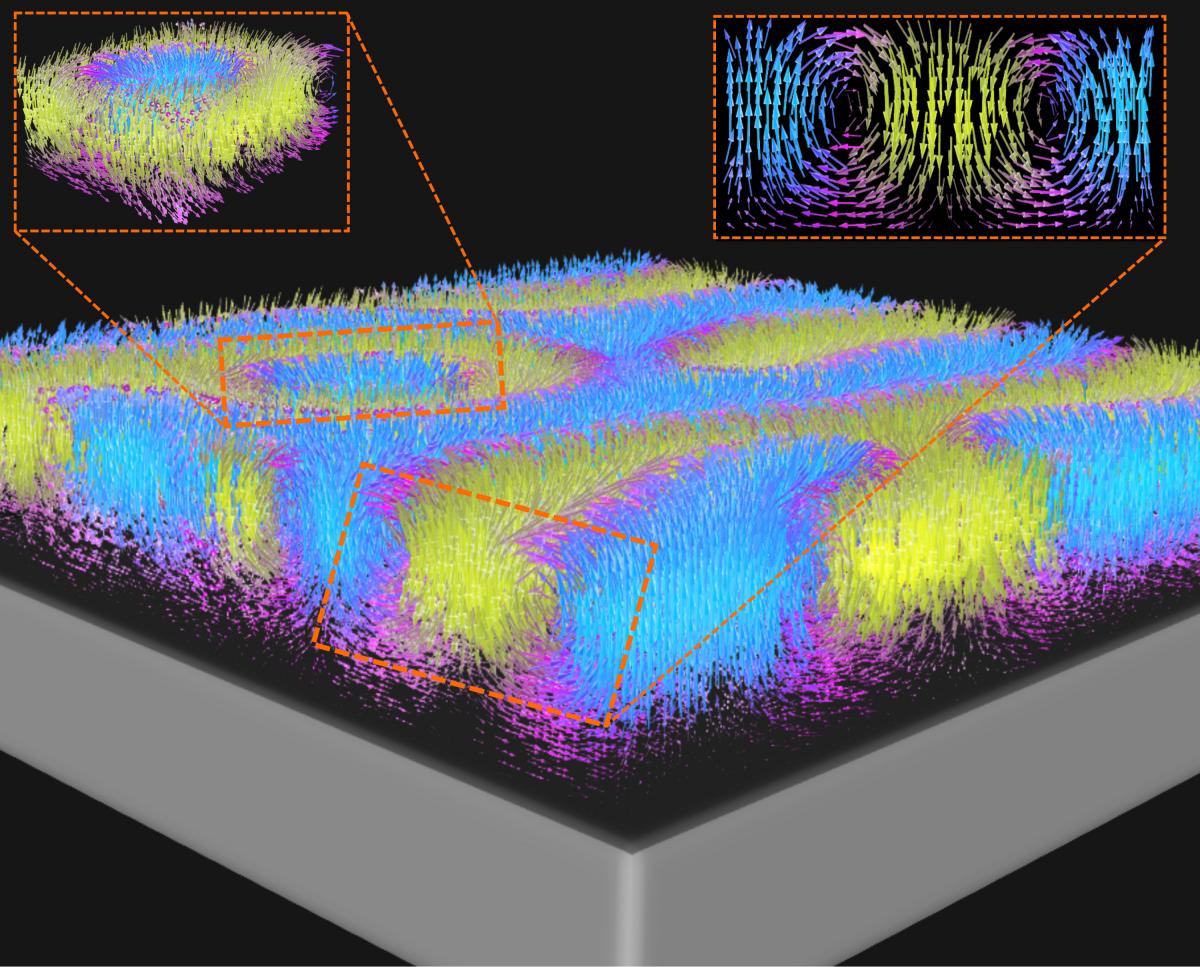
Entry #23
"Graphene nano-tablets"
Artist's Perspective: I was always fascinated to use microscopes in my childhood. We used to see a different world under the microscope. But we were seeing something that is already existing. When I become a scientist, now I am able to create my own world in the nano level. Yes, I am a nano civil engineer! I can create pillars, bridges, trenches, buildings everything in nano meter scale. I was very much excited to see this sample that I prepared under the scanning electron microscope. In the first look, I felt I am seeing some stripes of nano tablets. Most of us are using different types of tablets in our everyday life. I am always happy to relate my work with daily life so thought of giving its name as “graphene nano-tablets”.
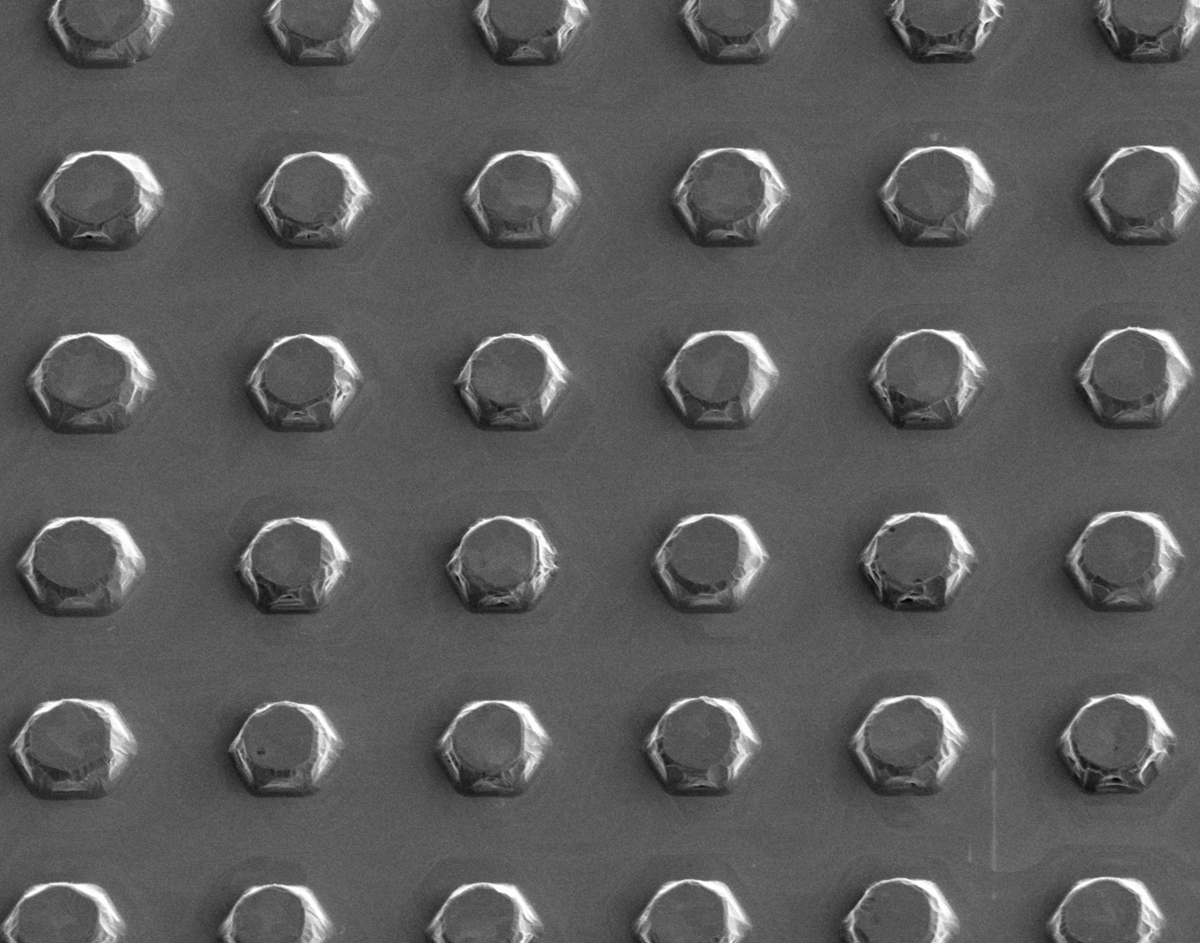
Entry #24
"Stars in the dark"
Artist's Perspective: While optical microscopy usually gives you a colorful and multifarious microcosmic world, fluorescence microscopy exhibits something pure and intrinsic. I was surprised the first time I found out that the normally triangular two-dimensional WS2 flakes were star-shaped lights standing out in the void. The fluorescence stands out with a beautiful shape and clear texture which reflects the inner atomic scale structure. The image was captured without color, but I adjusted it to return the true color of the fluorescence centered at 522 nm which can be seen by eye under the microscope.
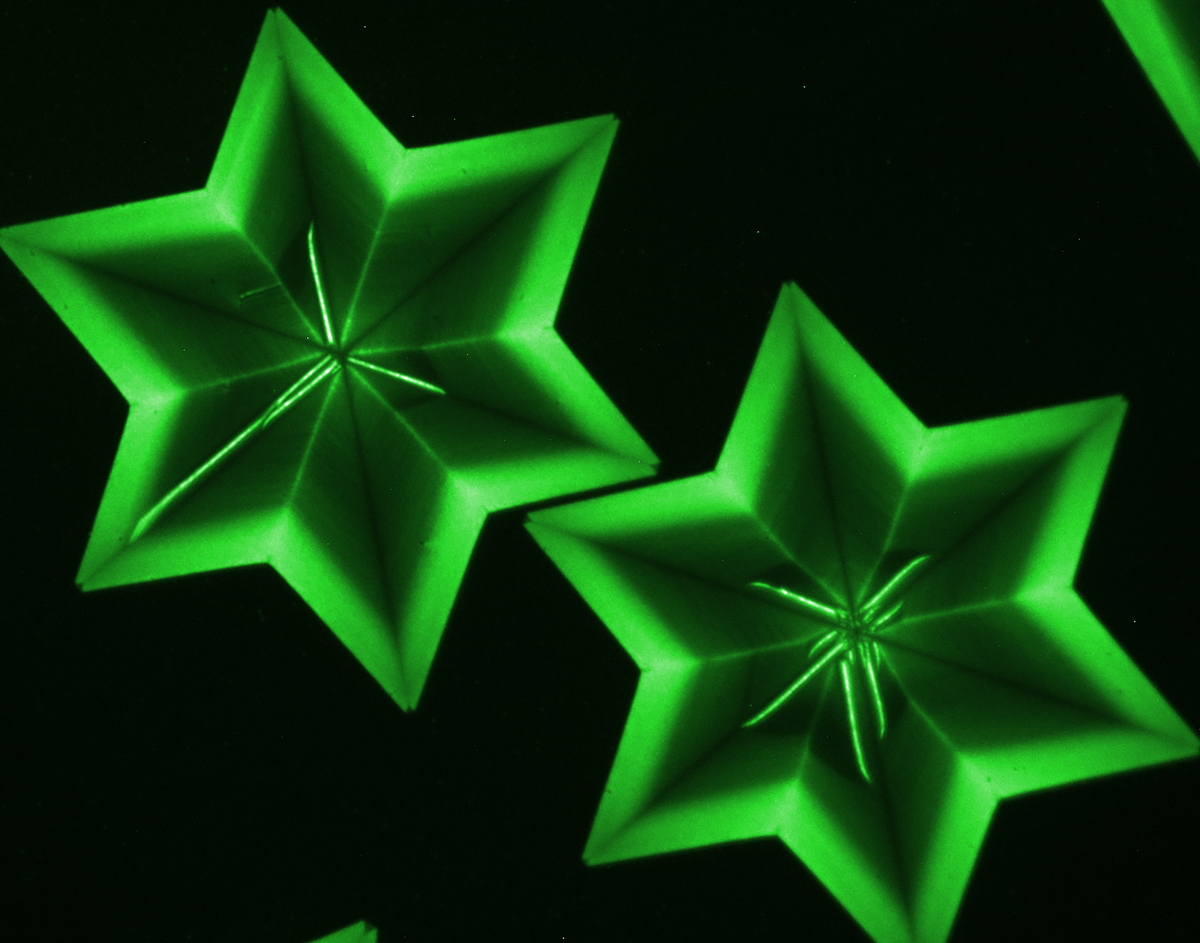
Entry #25
"Crystals in a Haystack"
Artist's Perspective: Many research programs aim to find the needle in a haystack, or a diamond in the rough. I was fortunate enough that through investigating a degraded surface of a single crystal, I was able to find this small cluster of crystals in a haystack of precipitates. These samples highlighted that every failed experiment can sometime have a silver lining.
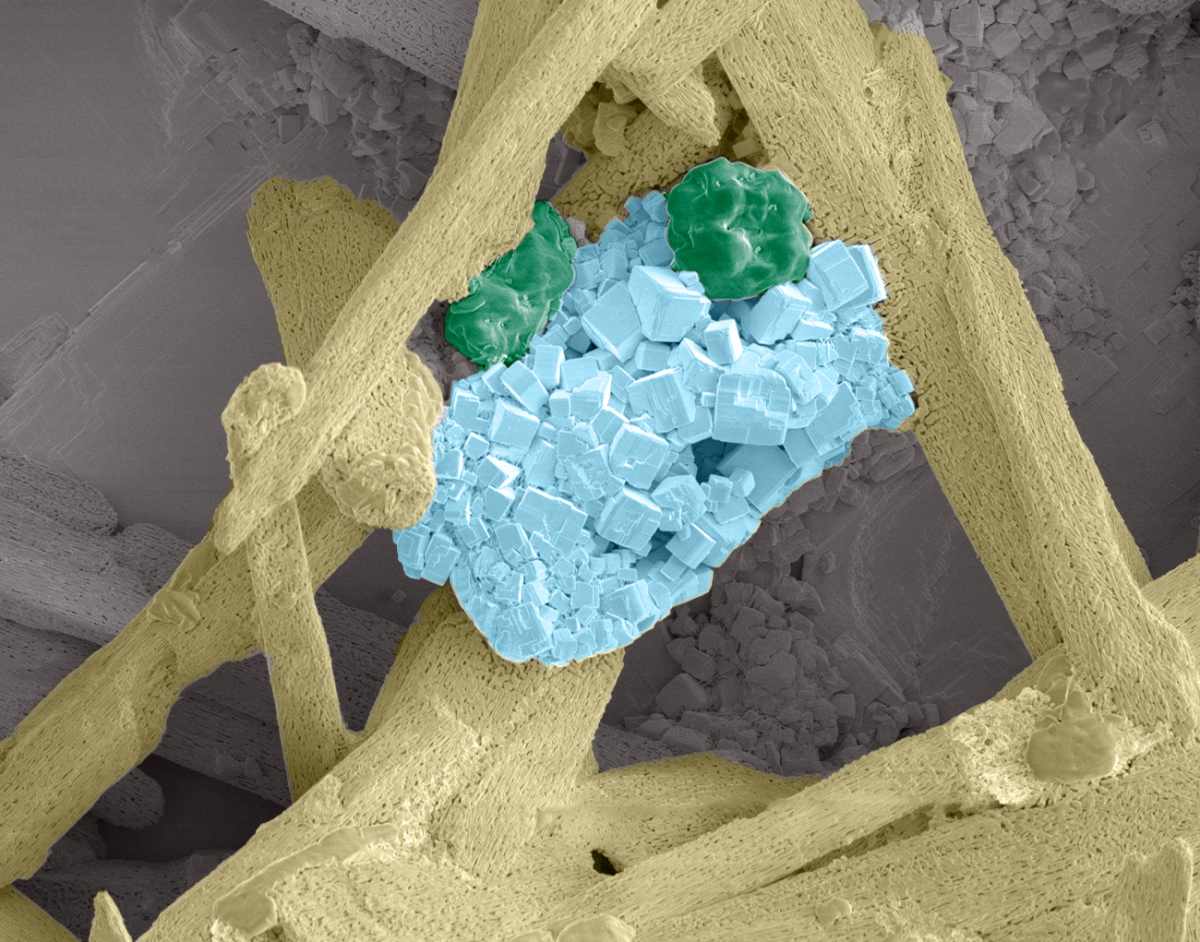
Entry #26
"Molly’s Comet: Orthorhombic Molybdenum Trioxide Crystals from Outer Space"
Artist's Perspective: Immediately bringing to mind images of glowing shooting stars, this image holds a striking similarity to some of the more fascinating denizens of the night sky. The green-and-purple coloration of the “comet tail” is brought about by a polarizing lens attached to the optical microscope paired with differing orientations of the oxide. The backdrop of the image, at first appearing devoid of interest, adds intrigue upon closer inspection as imperfections in the sapphire substrate enhance the cosmic overtone of the piece.

Entry #27
"Jupiter Unwrapped"
Artist's Perspective: Massive space bodies can take several forms, from starry plasma to cold and lonely rocks. Even our own solar system hosts a range gas giants and terrestrial planets, and many on Earth can recognize the looks and characteristics of each planet. Many would undoubtedly recognize the features manifested in this thermal spray coating as having a passing resemblance to our very own Jupiter. The chaotic, high pressure environment which conceived this coating is a well-fitting analogy for the harsh environment of Jupiter’s atmosphere.
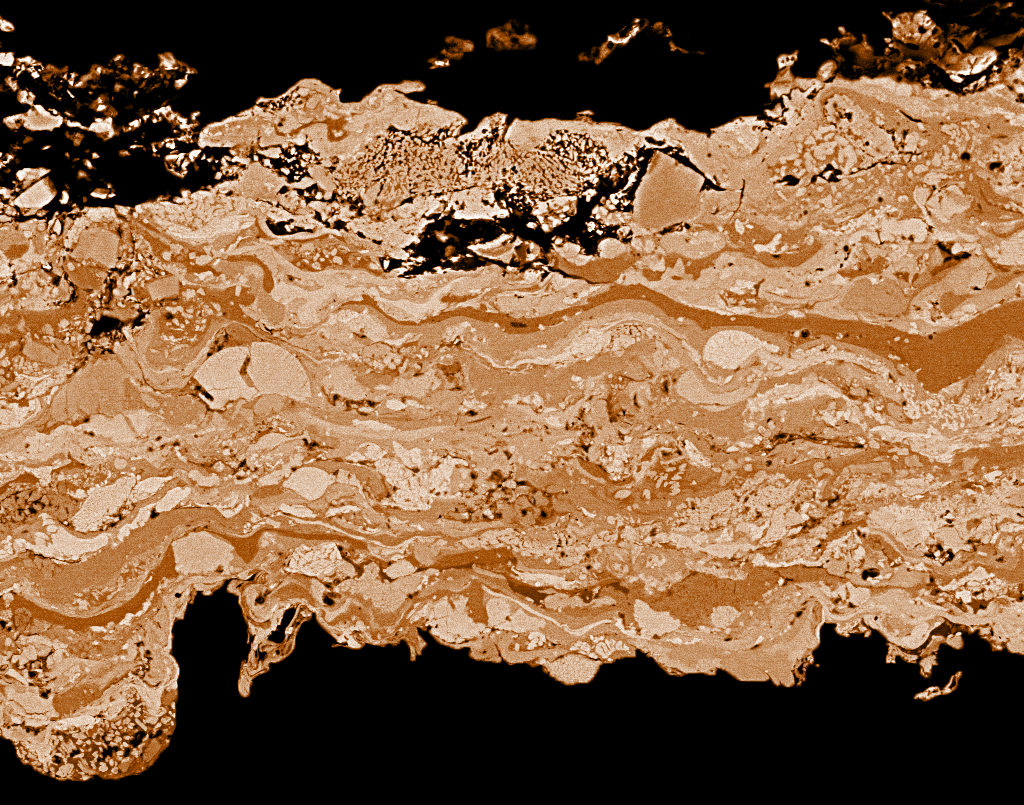
Entry #28
"Engineering Hierarchical Porosity in Granular Systems"
Artist's Perspective: The use of fluorescent microscopy often involves the use of a singular color. For this reason, 3D models may be difficult to visualize on a 2D plane. To address this issue, a depth gradient was used, allowing the viewer to see the natural spherical shape of the microgel. The resulting image was captivating to look at, even accounting for artist’s bias stemming from the hours of microscopy that it took to capture and model the final depiction.
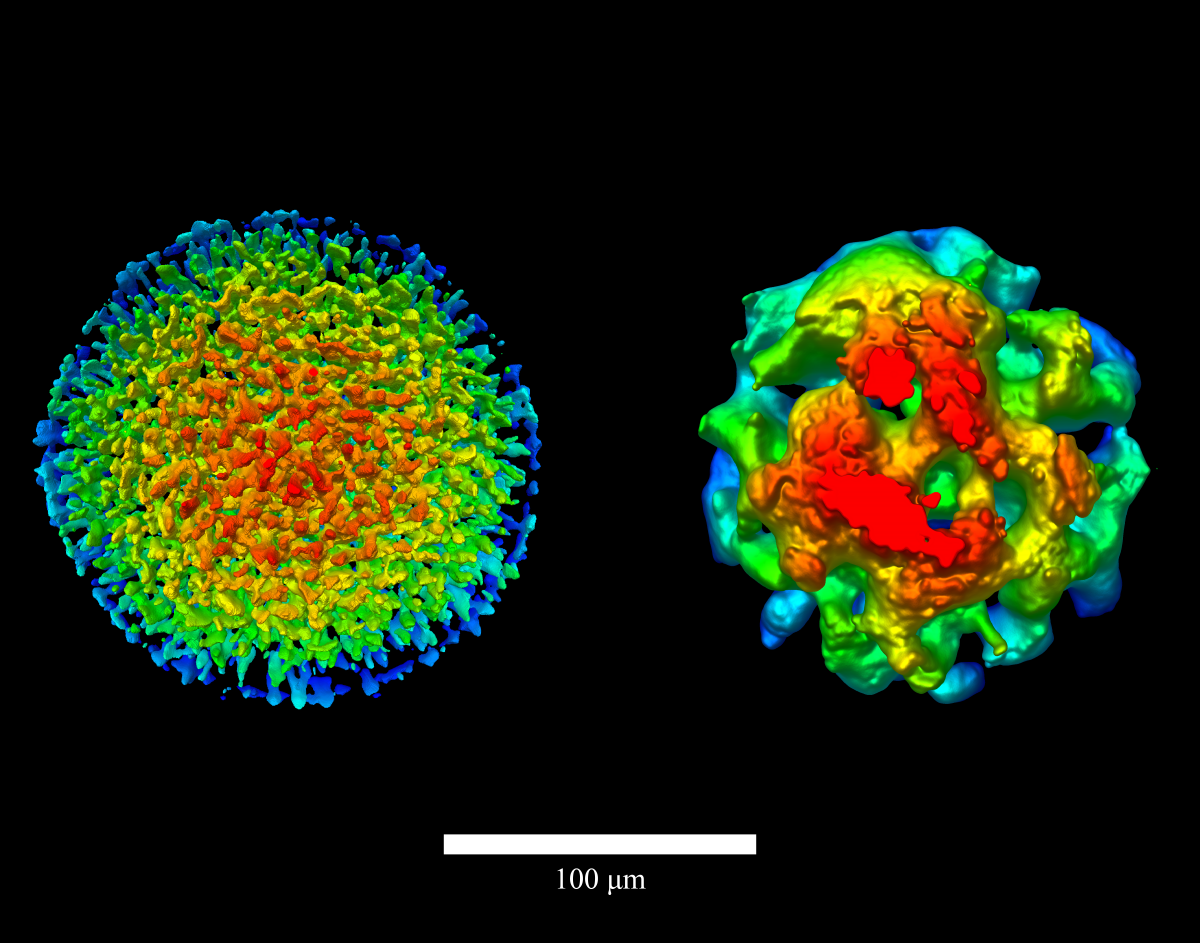
Entry #29
"Crashing Waves of a Rising Tide"
Artist's Perspective: The movement of crashing waves on a seashore and the effects of a rising tide, closely resembles the kinetics and thermodynamics of atomic movement. Just as waves are made up of molecules bobbing and weaving to and from in the oceans current, such is the case of vibrating atoms that traverse the anharmonicity of a potential energy well. While ocean particles are driven by the ocean current, the driving force for atomic motion is derived from the superposition of the repulsive and attractive forces two atoms may induce and/or exhibit with one another. The volume expansion and bond stretching within a material due to delamination, defect density, or thermal expansion results in a stretching and contracting nature of atomic bonds similar to the drifting of an ocean wave to and from the seashore.
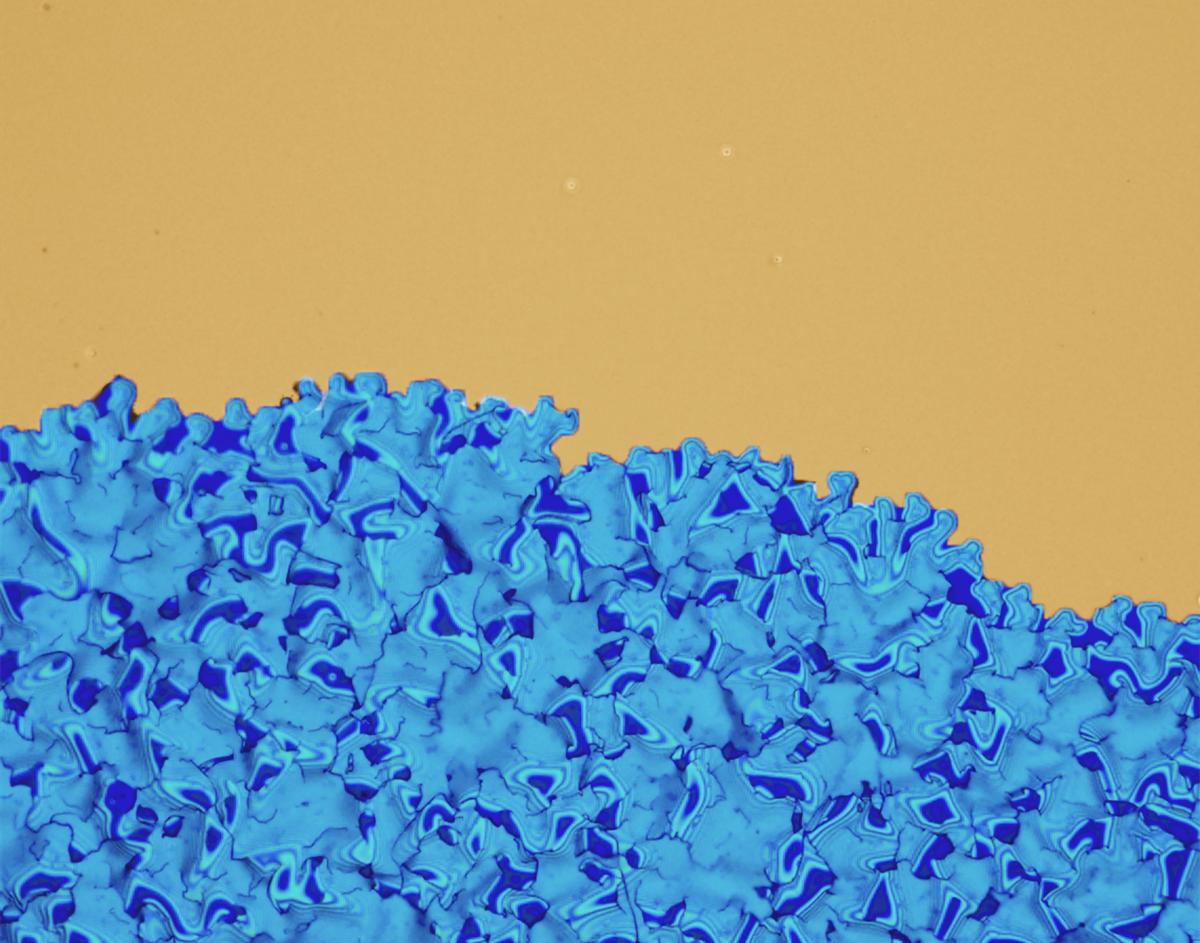
Entry #30
"Radioactive Squid Synergy"
Artist's Perspective: The figure is called radioactive squid energy because the ubiquitous radioactive sign may be seen in the image, which is unusual since hydrogen evolution reactions are a clean, sustainable source of energy. Another image that comes to mind is the image of three squid heads coming together, which may be thought of as the heads and the key scientific pillars that drive materials science and crystal chemistry.
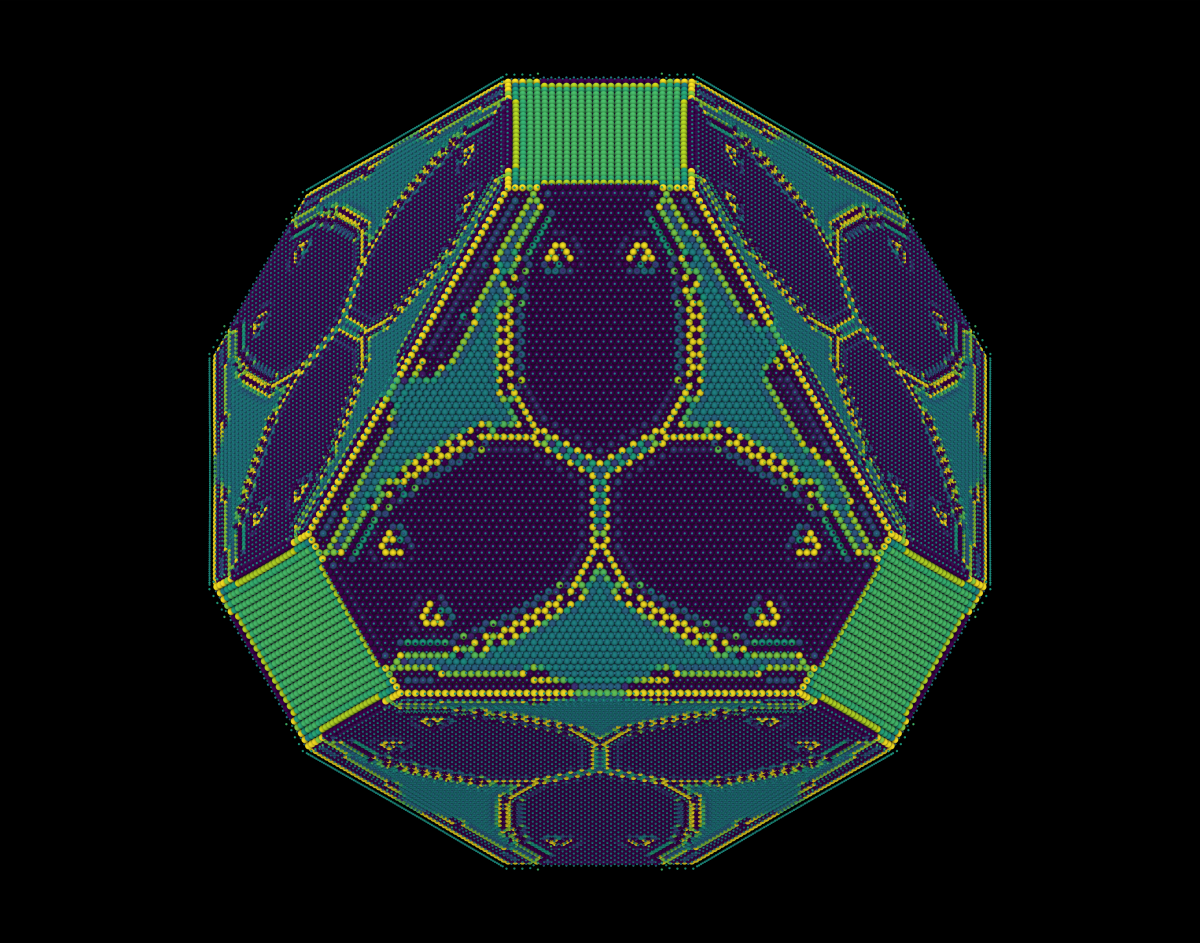
Entry #31
"A Micrograph of Fire and Ice"
Artist's Perspective: While I navigated across the grayscale surface of a cross-section, a tear in the Kevlar aramid nanofibers caught my eye. In this gorge, there were masses of fibers reminiscent of eldritch horrors and coniferous forests. However, to me, the most eye-catching feature was the two nanofibrous strands seemingly reaching out to one another. The duality of these fibers was the ultimate inspiration for my color palette. I colored the micrograph's bottom half red as the wispier microstructure reminded me of fire. In contrast, the top half of the micrograph was a bit denser and more blockish like ice, inspiring me to color it blue.
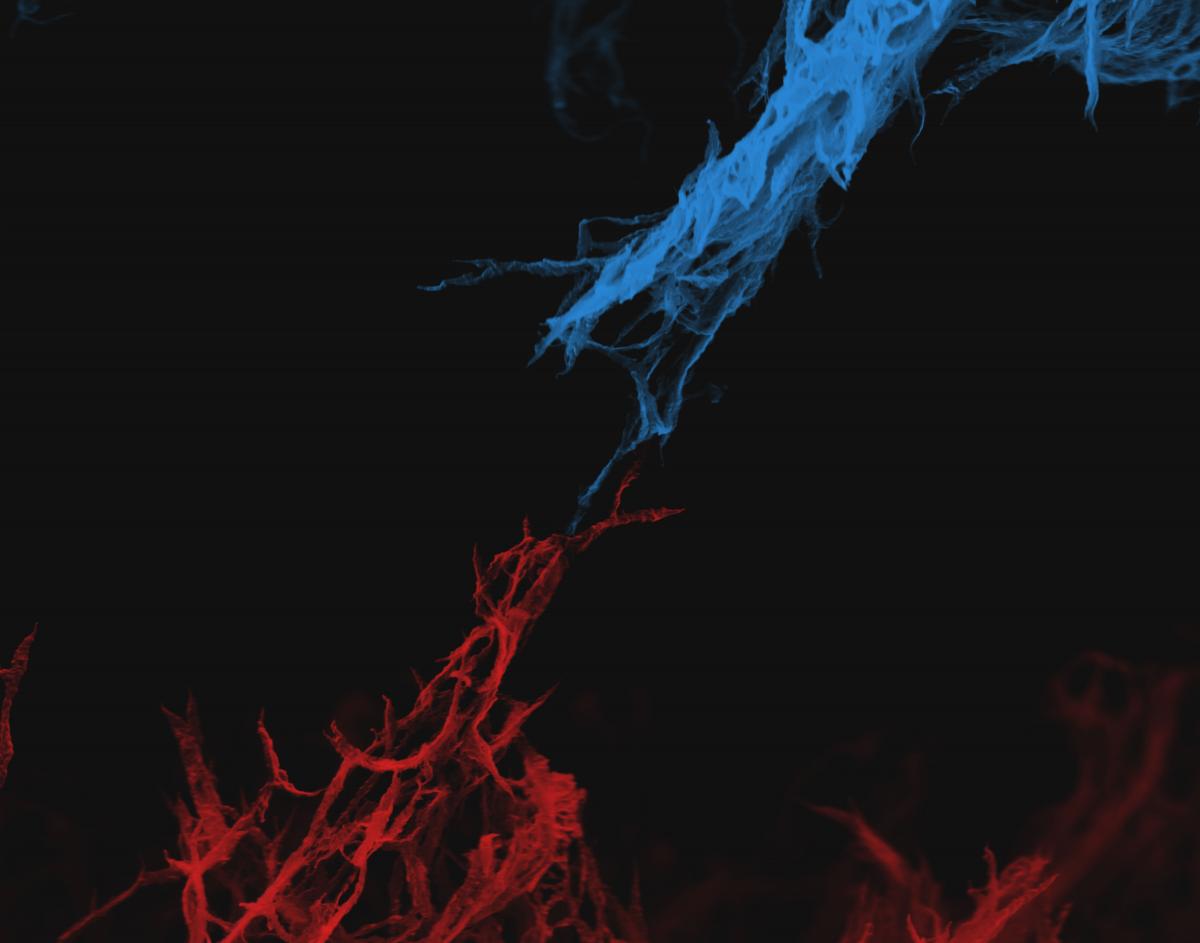
Entry #32
"Order Among Disorder: Stained Glass Windows of Molybdenum Trioxide on a Mica Substrate"
Artist's Perspective: The patterns and coloration that appear in this image are reminiscent of the stained glass windows that have been prevalent in churches and other religious buildings for a thousand years. However, this may not come as an instantaneous realization to all viewers; at first glance, the image may appear pretty, but messy and without any structure or order. Nevertheless, the highly regular orientations and angles that form the dark "frames" for our stained glass panes distinguish the image from a purely random collection of colors. In addition to reminding us of the previously mentioned art medium, the juxtaposition of uninhibited color and rigid order may give us cause to reflect on how much uniqueness and vibrancy can exist within the constraints of any given situation.
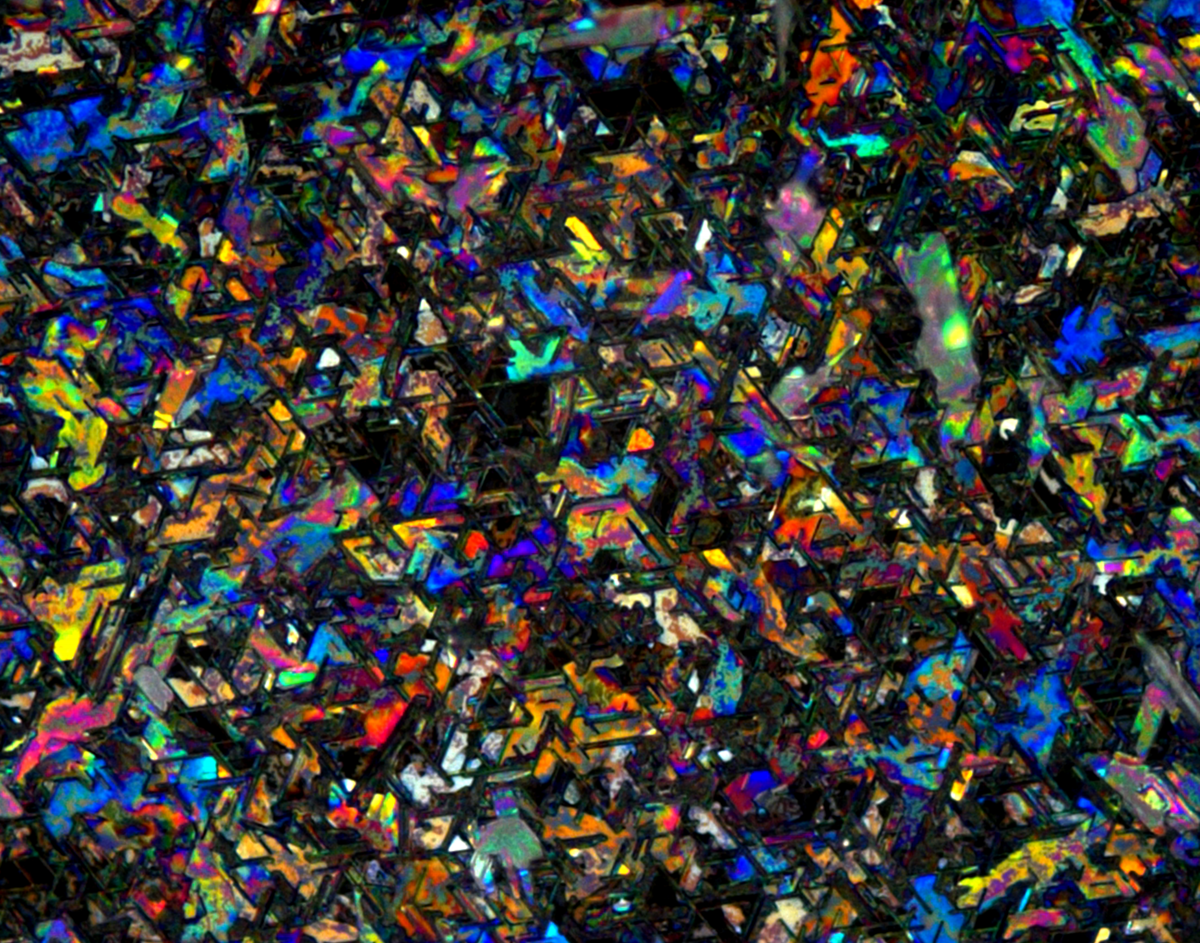
Entry #33
"Liquid Crystal Thin Film Relaxing"
Artist's Perspective: In this particular picture, we were first setting up our color camera and happened to take a few pictures before the needle began to oscillate. Here the liquid crystal thin film is relaxing from when we centered the needle. I was able to watch the film slowly unwind for the first time in color.
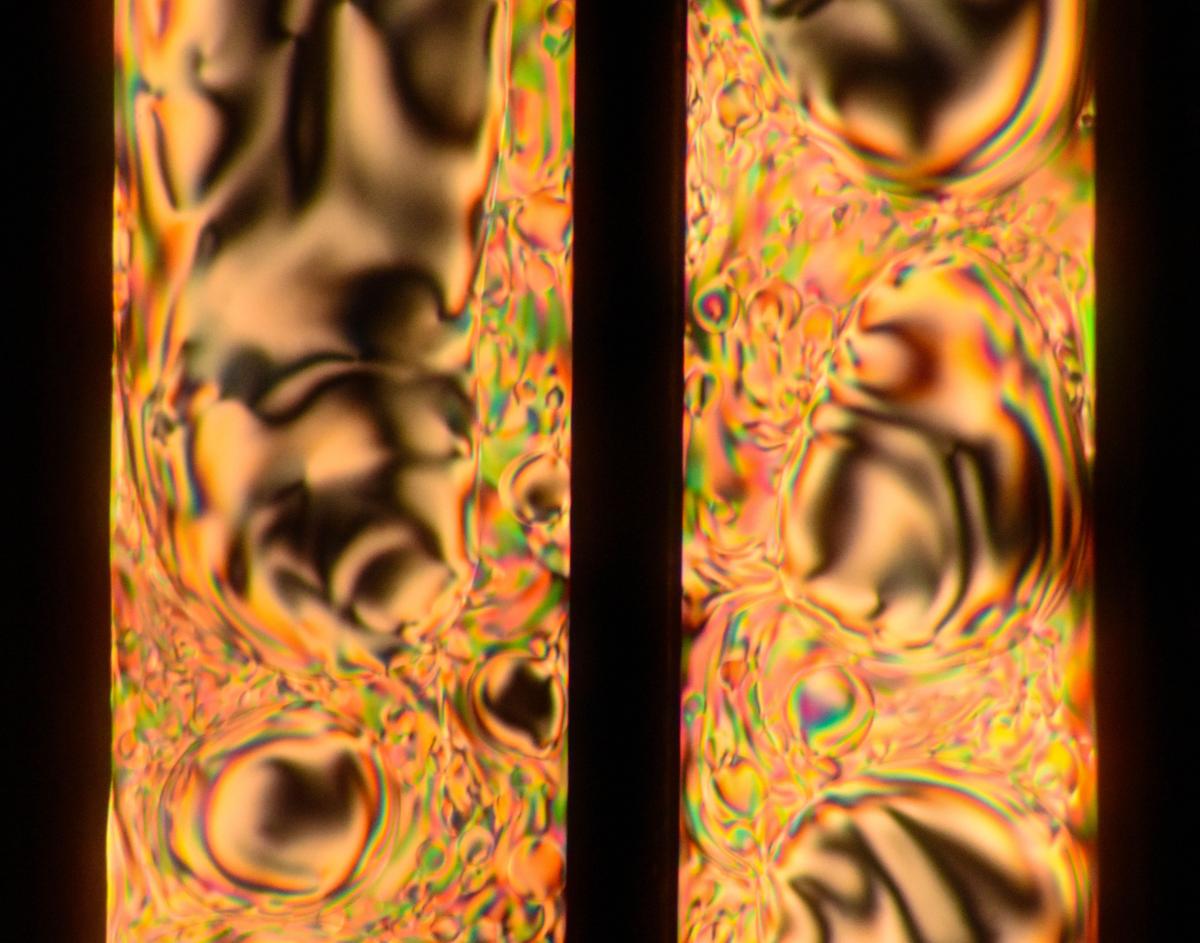
Entry #34
"A Kaleidoscope of Hidden Easter Eggs"
Artist's Perspective: Despite the fact that Pt is considered the ideal material for fuel cell generation from a catalytic viewpoint, it is not a realistic material from a cost standpoint. This picture depicts oxidized Pt nanoparticles in an aqueous solution for oxygen reduction reactions (ORR). Since developing new materials for renewable energy sources means adopting a new way of thinking. Kaleidoscopes are used to view optical images from different perspectives, and Easter eggs are considered new and unique features or surprises in games and movies. Hence, this image has been dubbed a "Kaleidoscope of Hidden Easter Eggs." Thus, by taking a fresh look into ORR reactions and the interactions surrounding them, scientists may be able to discover and unlock new surprises and features for fuel cell technology.
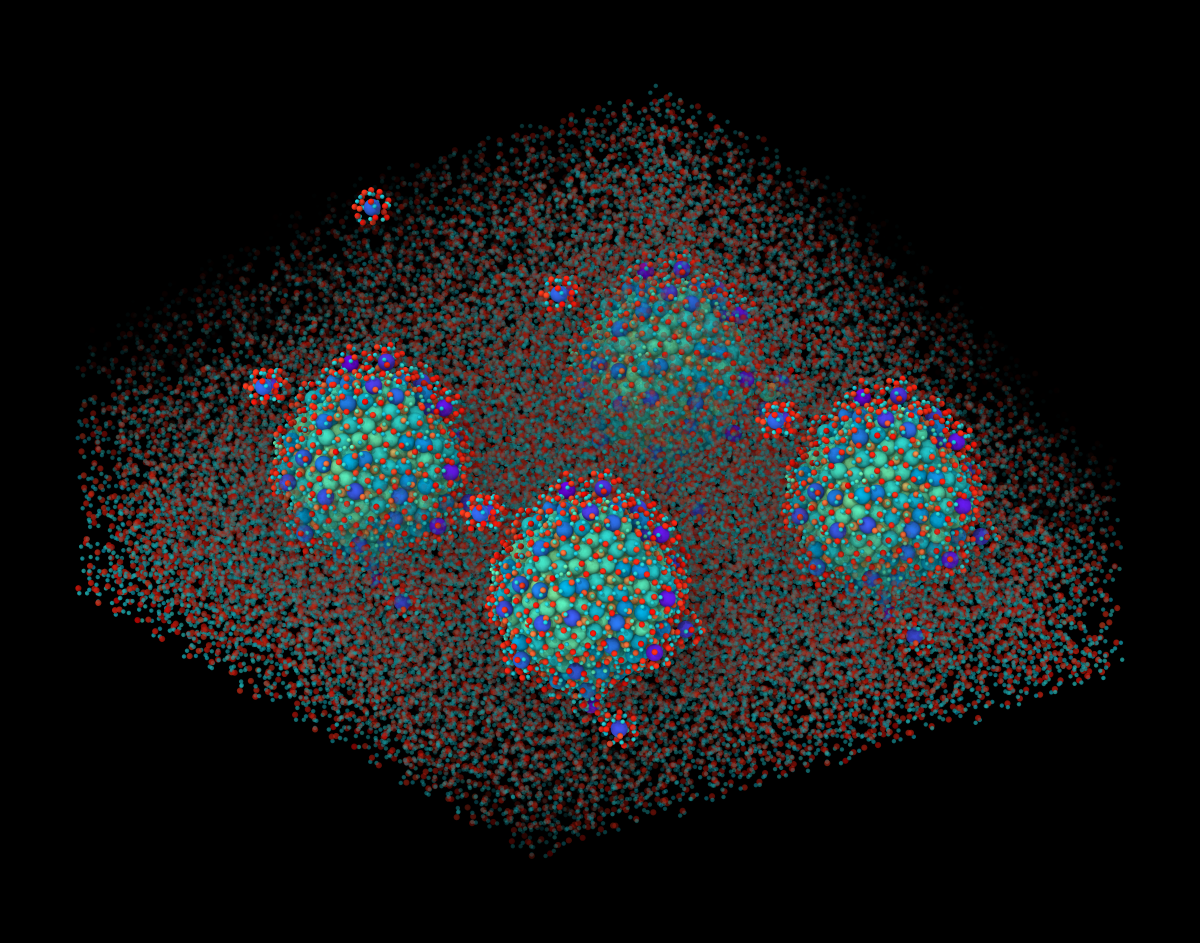
Entry #35
"Universe of Boron Stars"
Artist's Perspective: Imagine being surrounded by endless stars. As far as your eye can see there are only the ripples of these majestic boron stars, all with their own unique shape and personality. Some are big, some are small, and some have curious “eyes” that catch you in their eternal gaze. This image allows us to bring the microscopic into the macroscopic and do just that. There’s nothing more awe-inspiring than the vast expanse of space filled with countless balls of hot gas and rock. Here, we’ve created a universe of single elemental stars that can be held in the palm of your hand. What if these boron stars had planets of their own? A universe inside another universe.
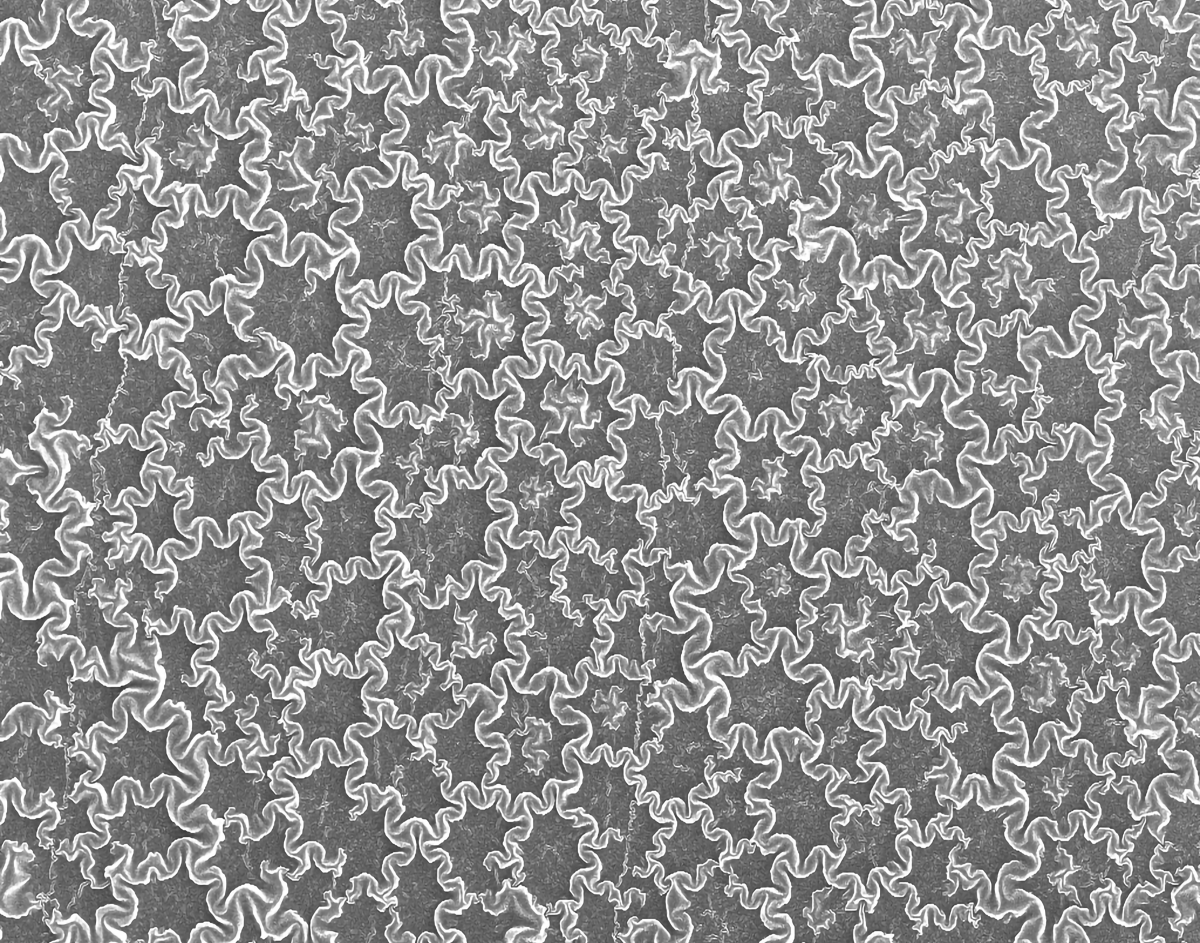
Entry #36
"Fireworks in Disneyland: diffraction pattern of organic thin-film grew on graphene"
Artist's Perspective: Walt Disney once said, “Disneyland will never be completed. It will continue to grow as long as there is imagination left in the world.” Now, imagination has introduced Disneyland to the nanoworld. The Grazing incidence X-ray diffraction (GIXD) diffraction pattern of organic thin-film grew on graphene reminds me of the stunning fireworks that light up the night sky at Disneyland. Here, GIXD allows us to determine the crystallinity, crystal packing, and orientations of radiation-sensitive organic soft materials. Such rapid revolution in instrumentation at synchrotron facilities brings magic to the organic thin film study, and we can discover more that we could not before.
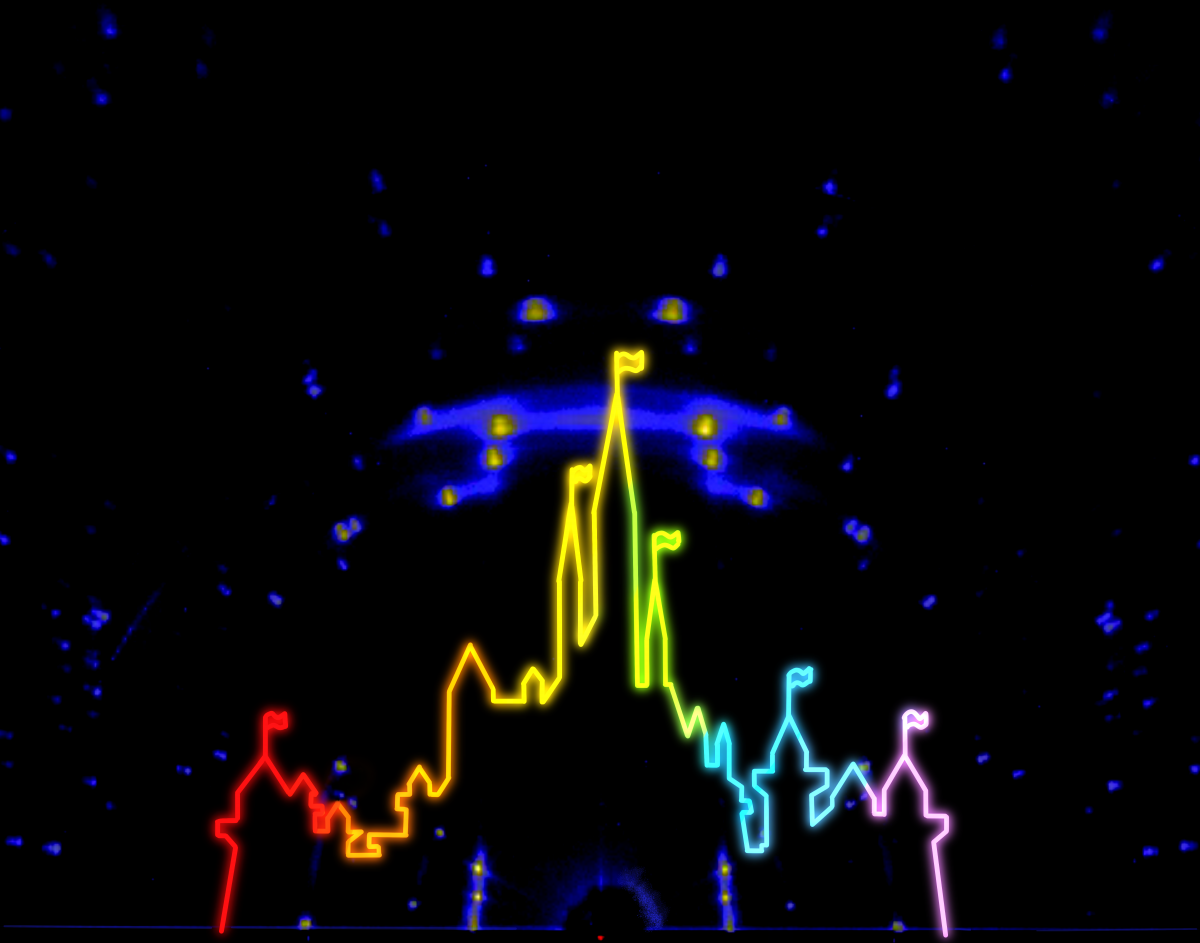
Entry #37
"MoS2aic Tessellation: Nanoscale Tetris with Chemical Vapor Deposition"
Artist's Perspective: Looking back to previous MVC editions, I noticed that atomic force microscopy (AFM) is rarely featured. With this false-colored micrograph, I wanted to display that in addition to being a really powerful surface metrology technique, AFM can produce beautiful images. From nuclei developing into sharp hexagonal crystals, to spiral-like growth, the image displays some of the magic behind the curtains of chemical vapor deposition chambers. What I find especially captivating about the image is that the viewer can clearly see the tessellation of hexagonal MoS2 grains into larger crystals which happens during growth.
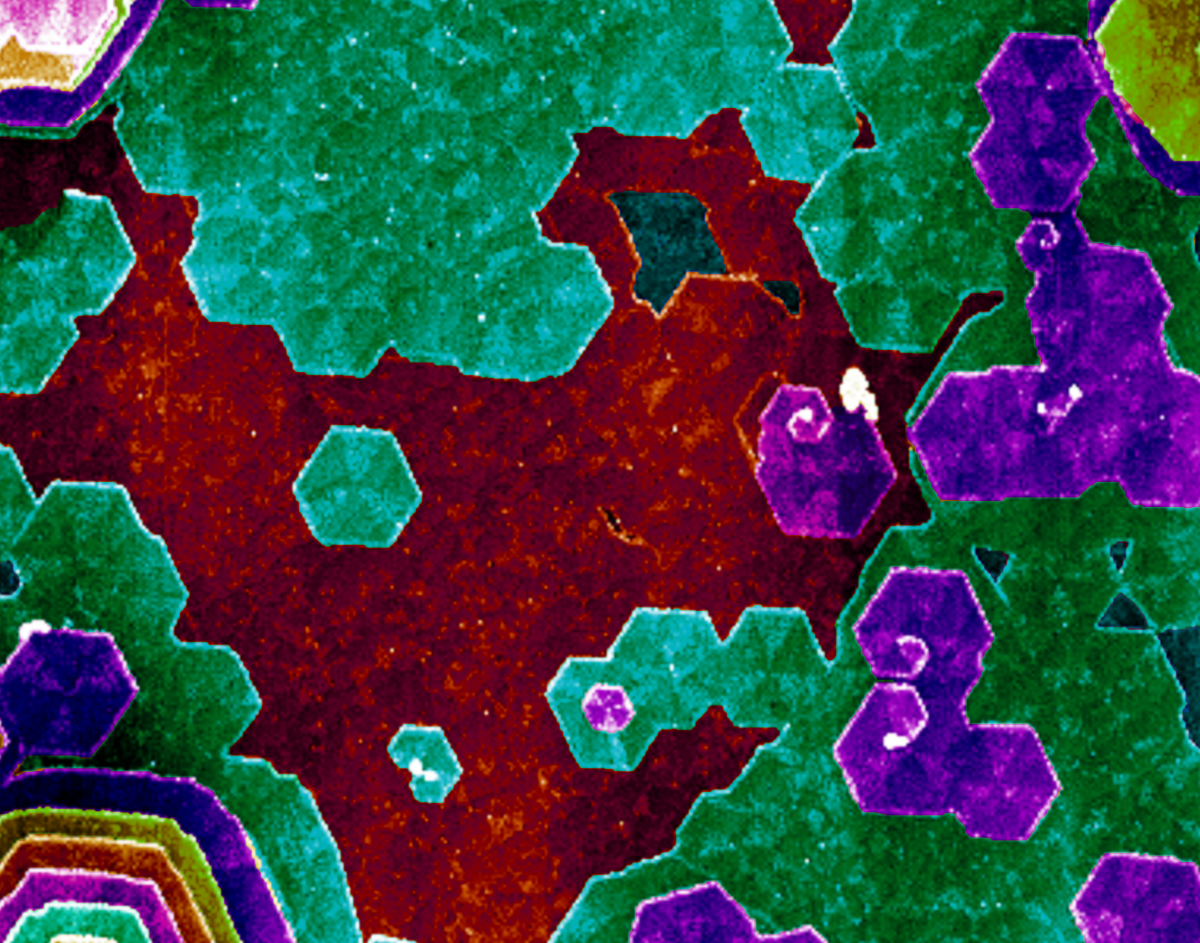
Entry #38
"Microscopic Meteor Shower"
Artist's Statement: Sometimes a scanning electron micrograph (SEM) in its purest black-and-white form is simple enough to inspire through the eyes of the observer. Having always been fascinated with outer space, I saw the immediate parallelism between the scene in this image and those scenes of the extraordinary world. Only limited by my imagination, I'm sure this depiction is strikingly similar to one far away from here, some cosmic instance in time and space. Instead of space rock spiraling toward a planetary body, this image captures the agglomeration of macroparticles during cathodic arc physical vapor deposition (PVD) of a thin-film Cr coating onto a Zr substrate. I guess it's only fitting to find a microcosm in a microscope.
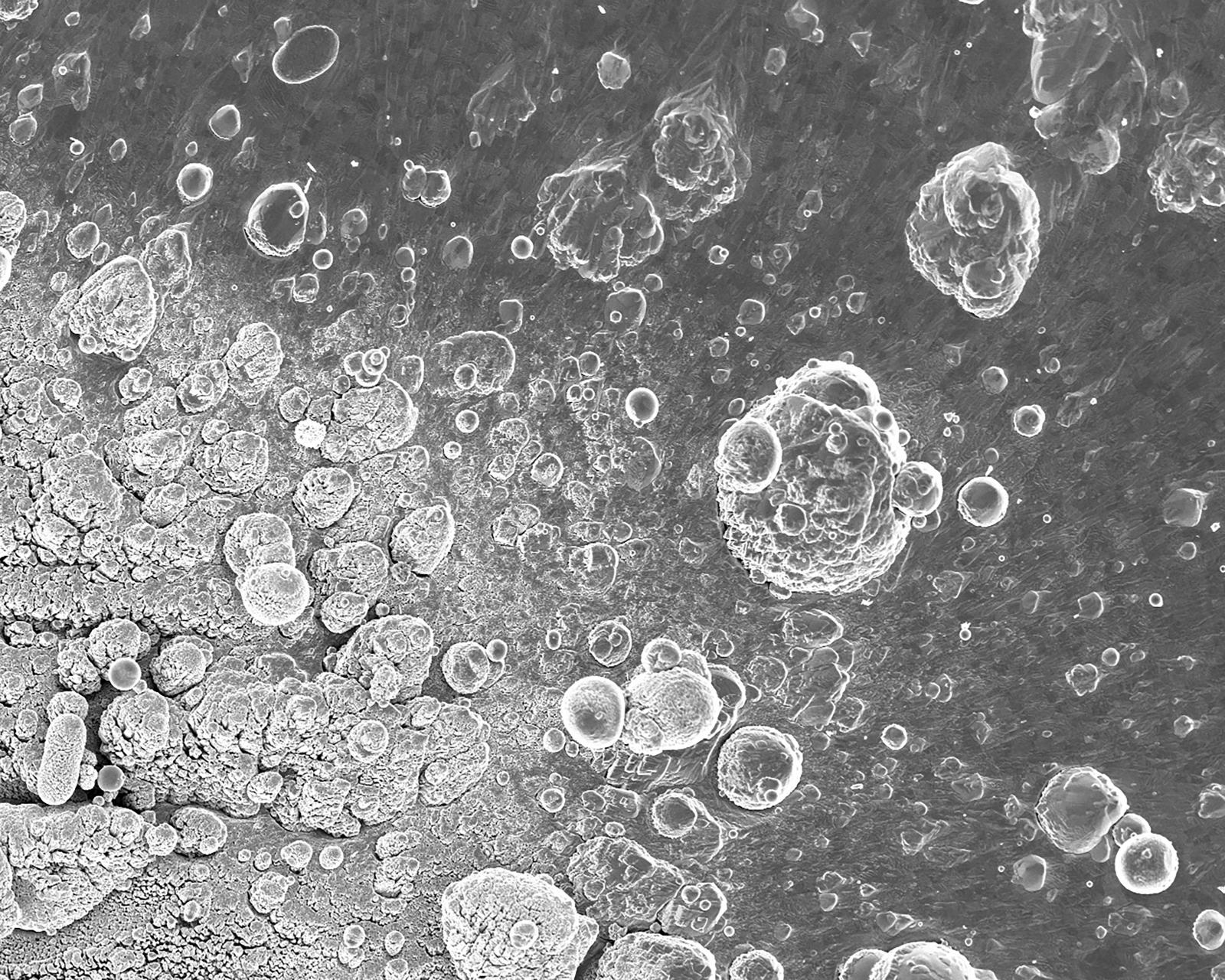
Entry #39
"Passage of Cracks"
Artist's Statement: How striking are the similarities between what we call inanimate objects like metals and the human body! On one hand, when the metal fails to carry the burdened load, it forms cracks to release the imposed energy through opened passages. On the other hand, if the host is a living being, we call these passages veins which carry blood, through all the possible parts of the body to give life to its host. As the saying goes, life has a way of working itself out, and probably it is by either flooding blood through to the veins or opening cracks to let the intangible energies pass
